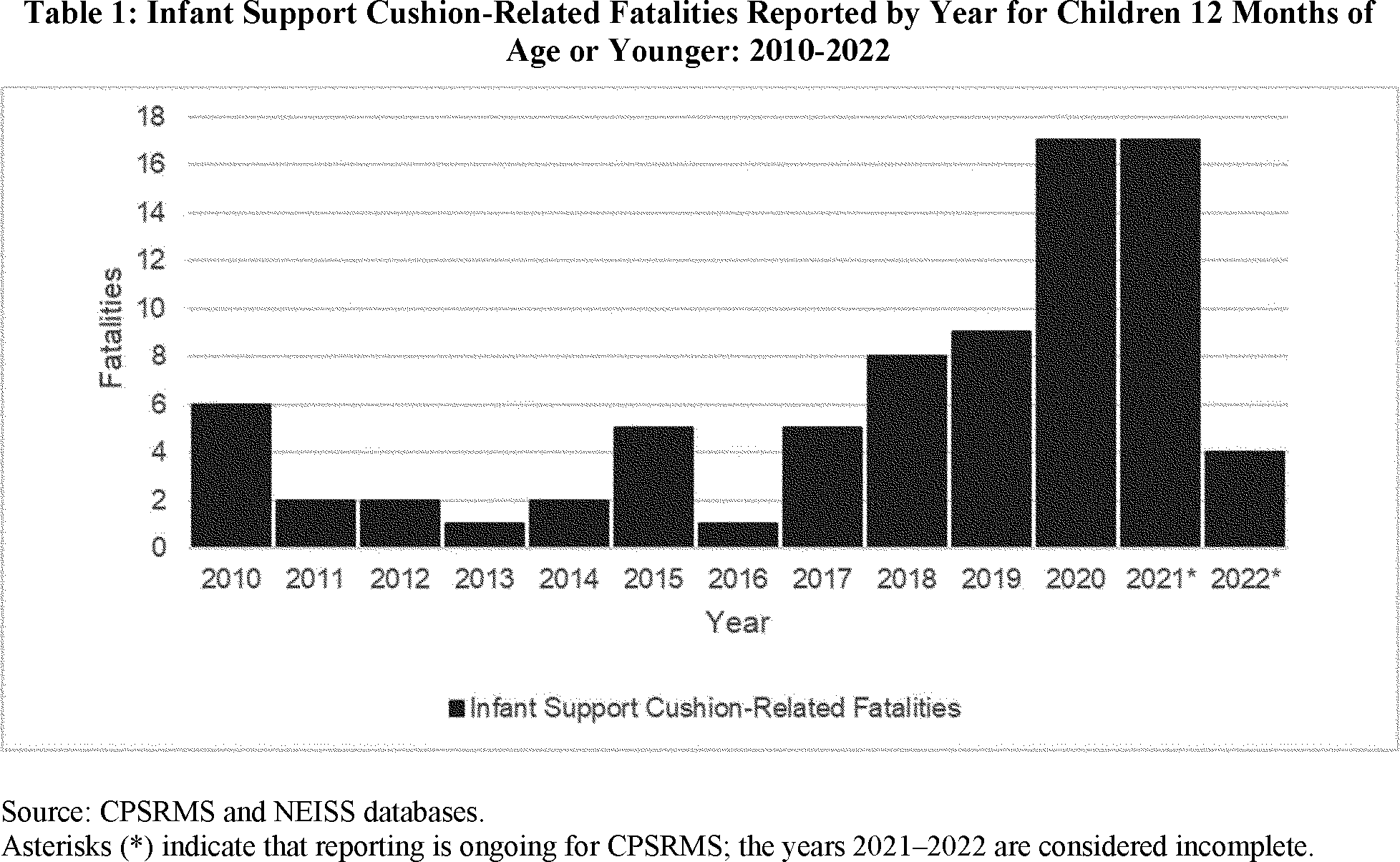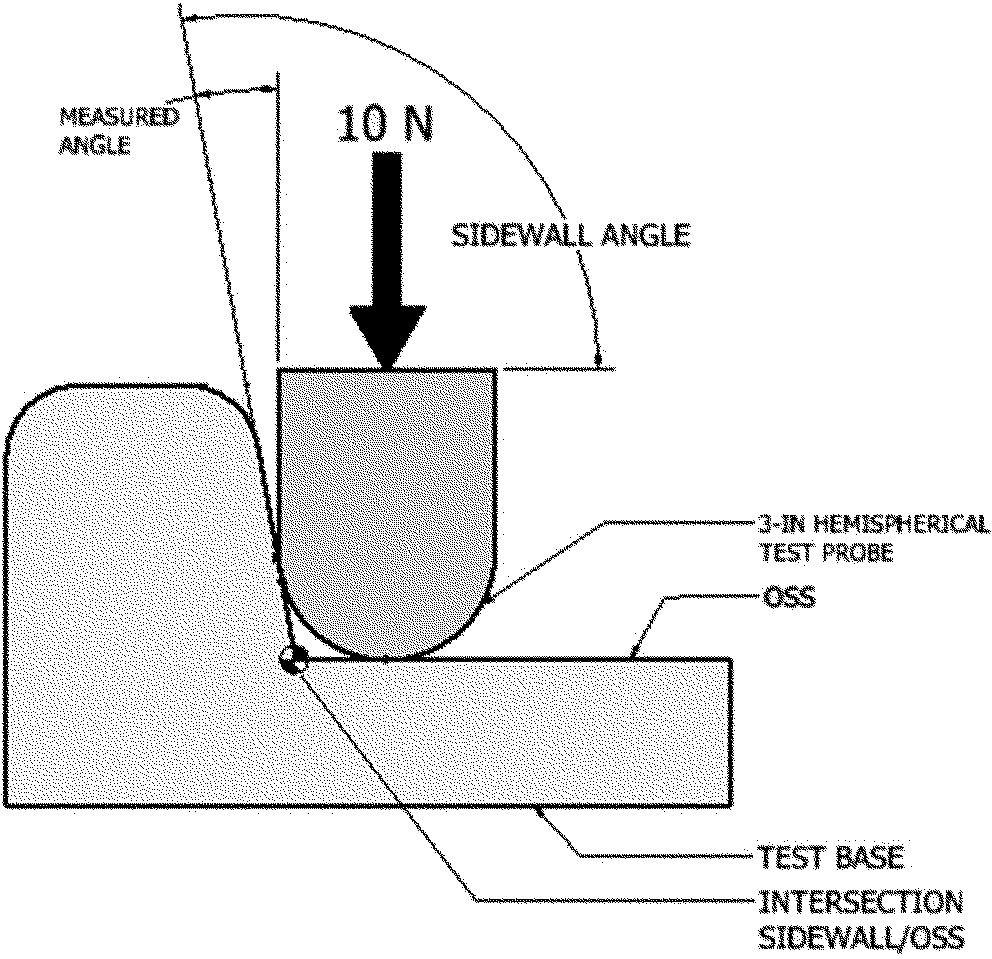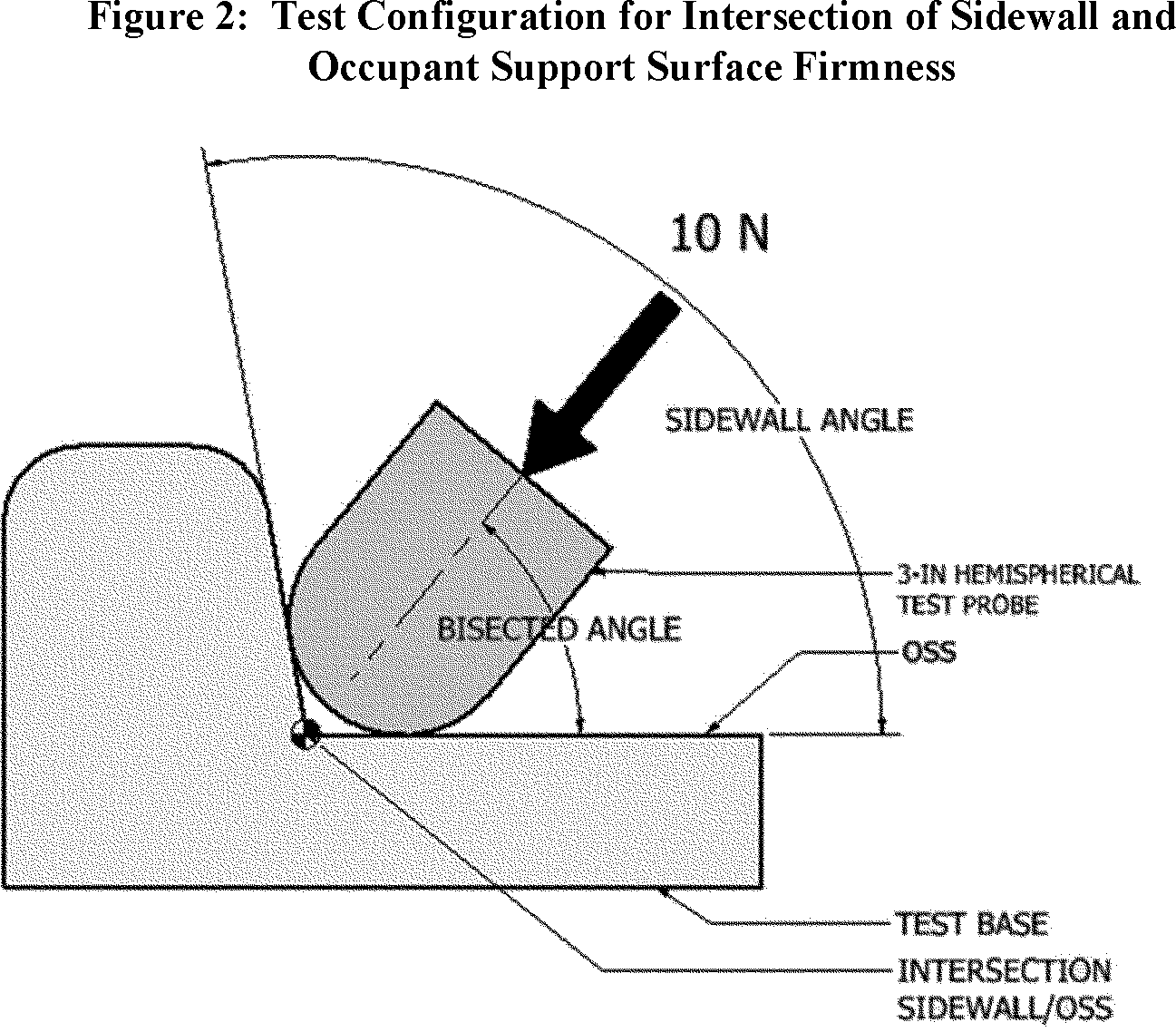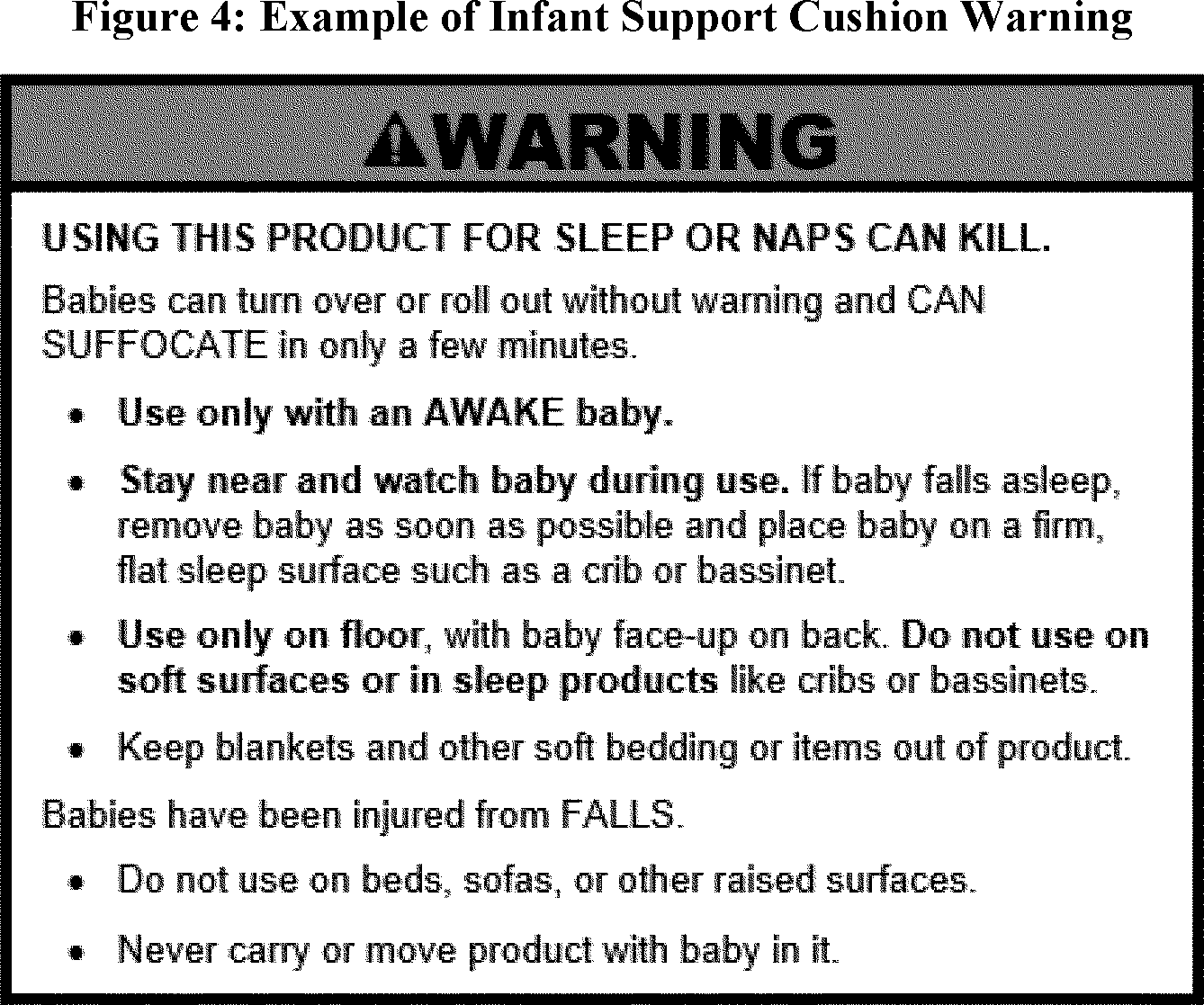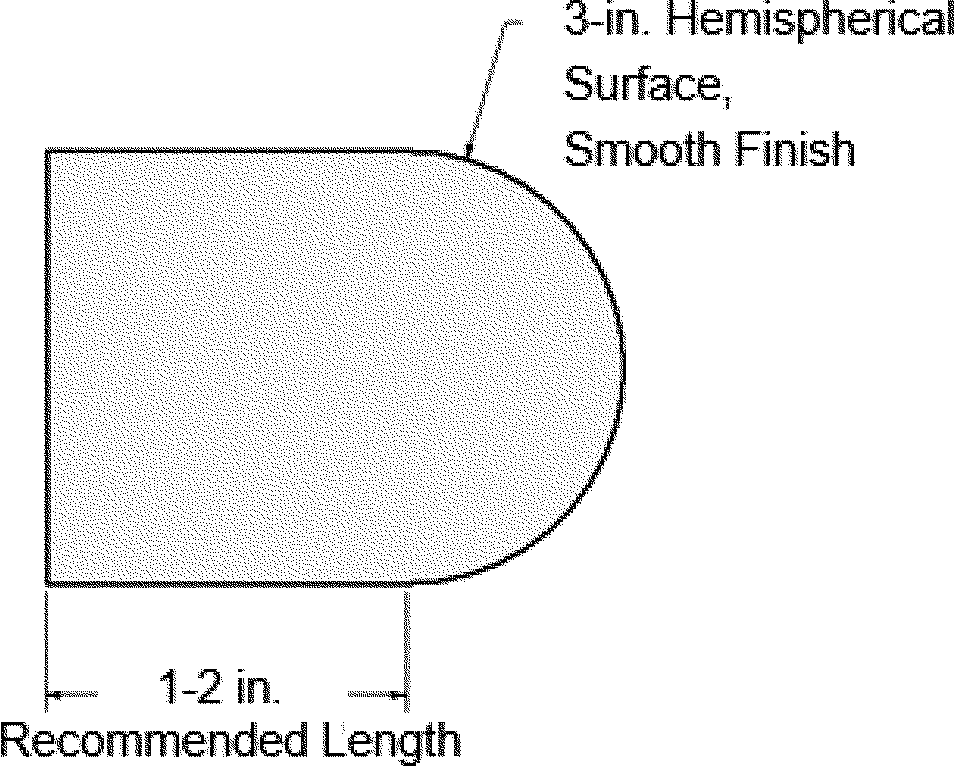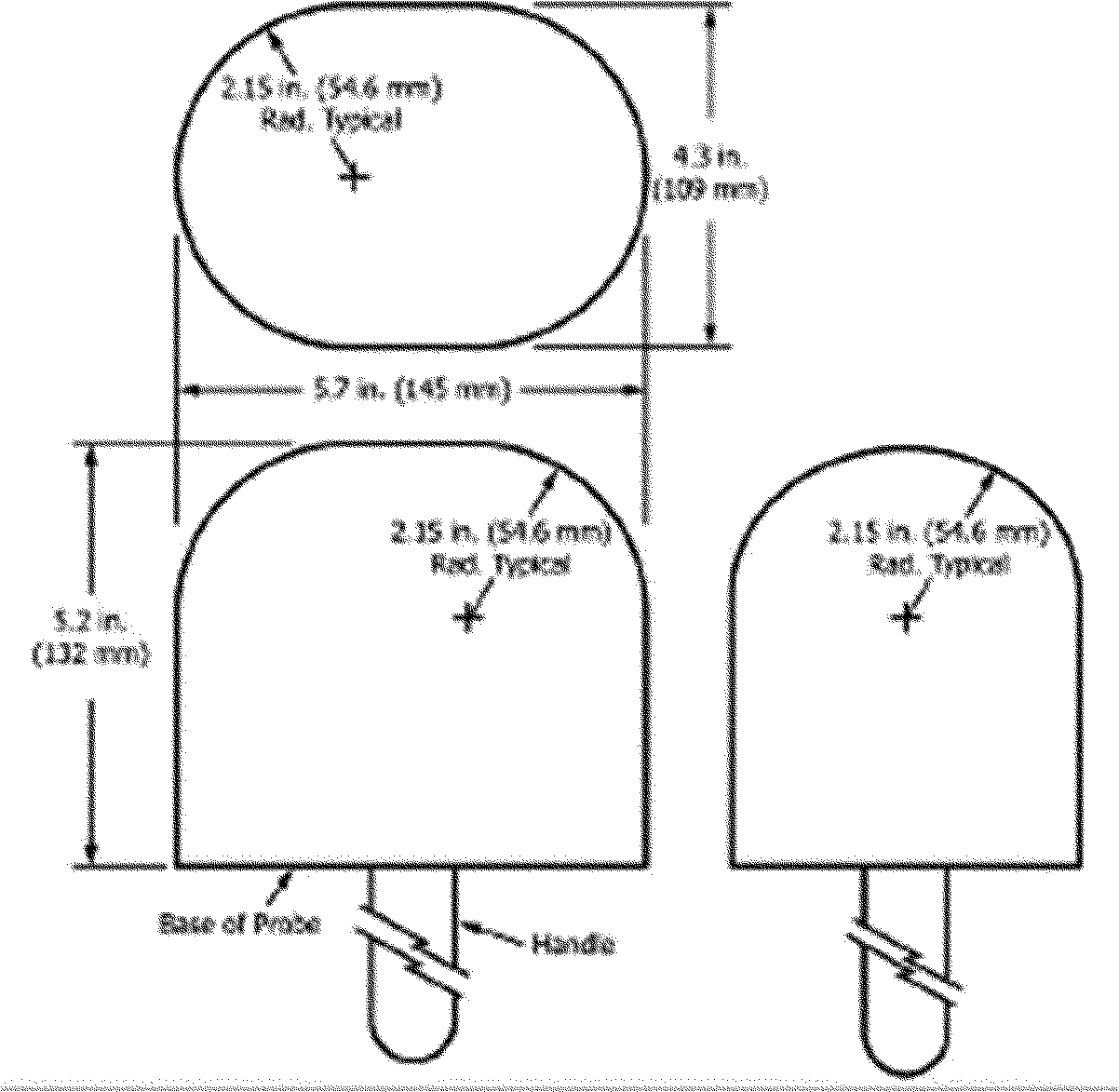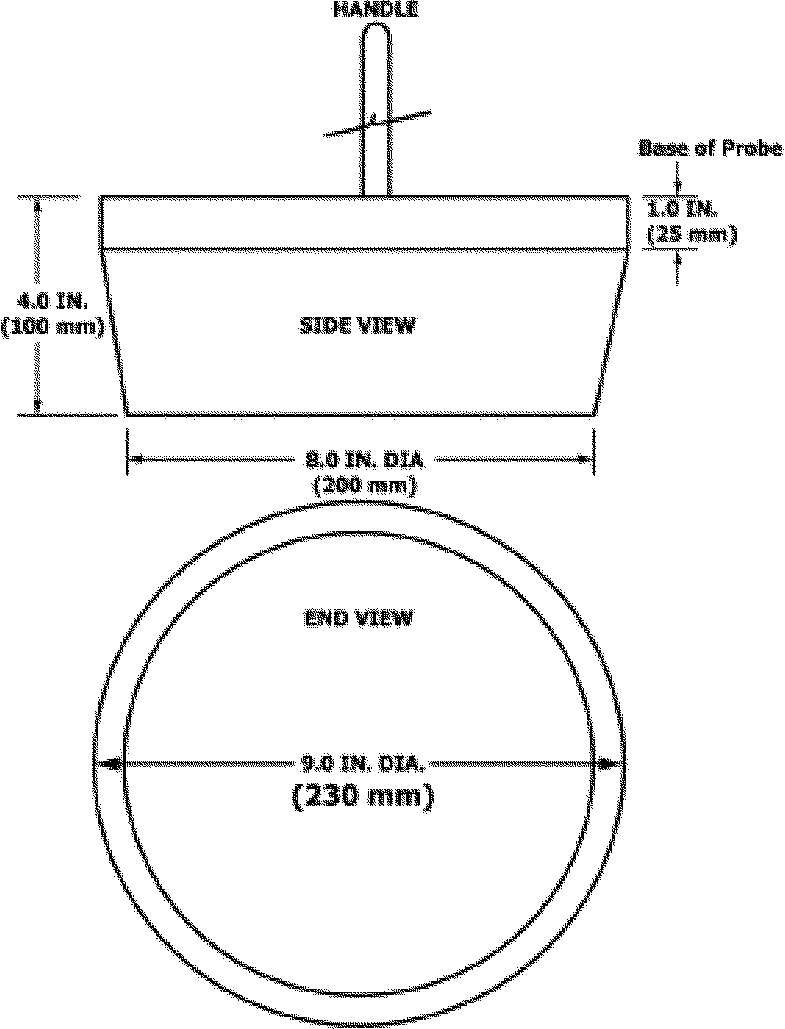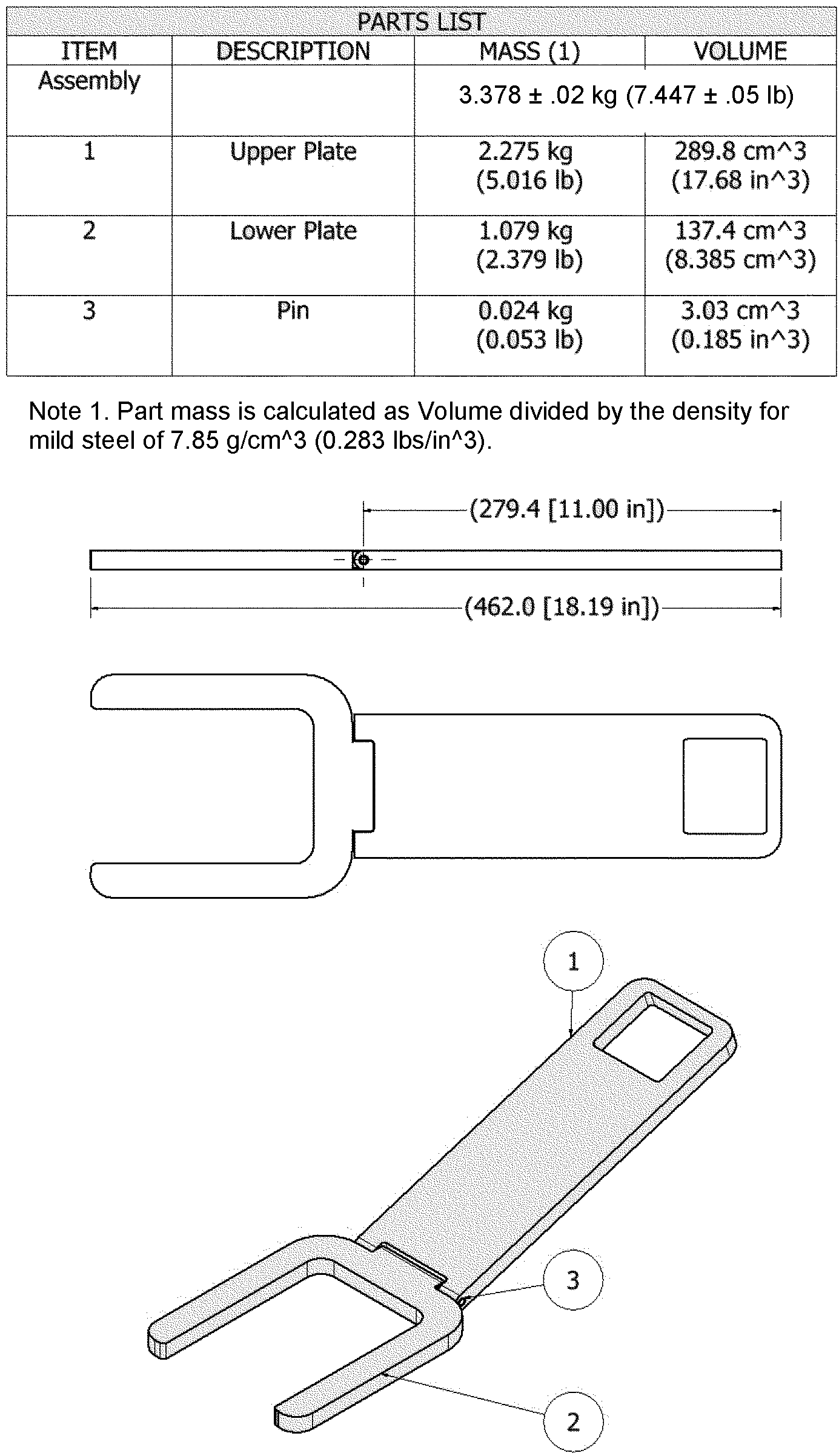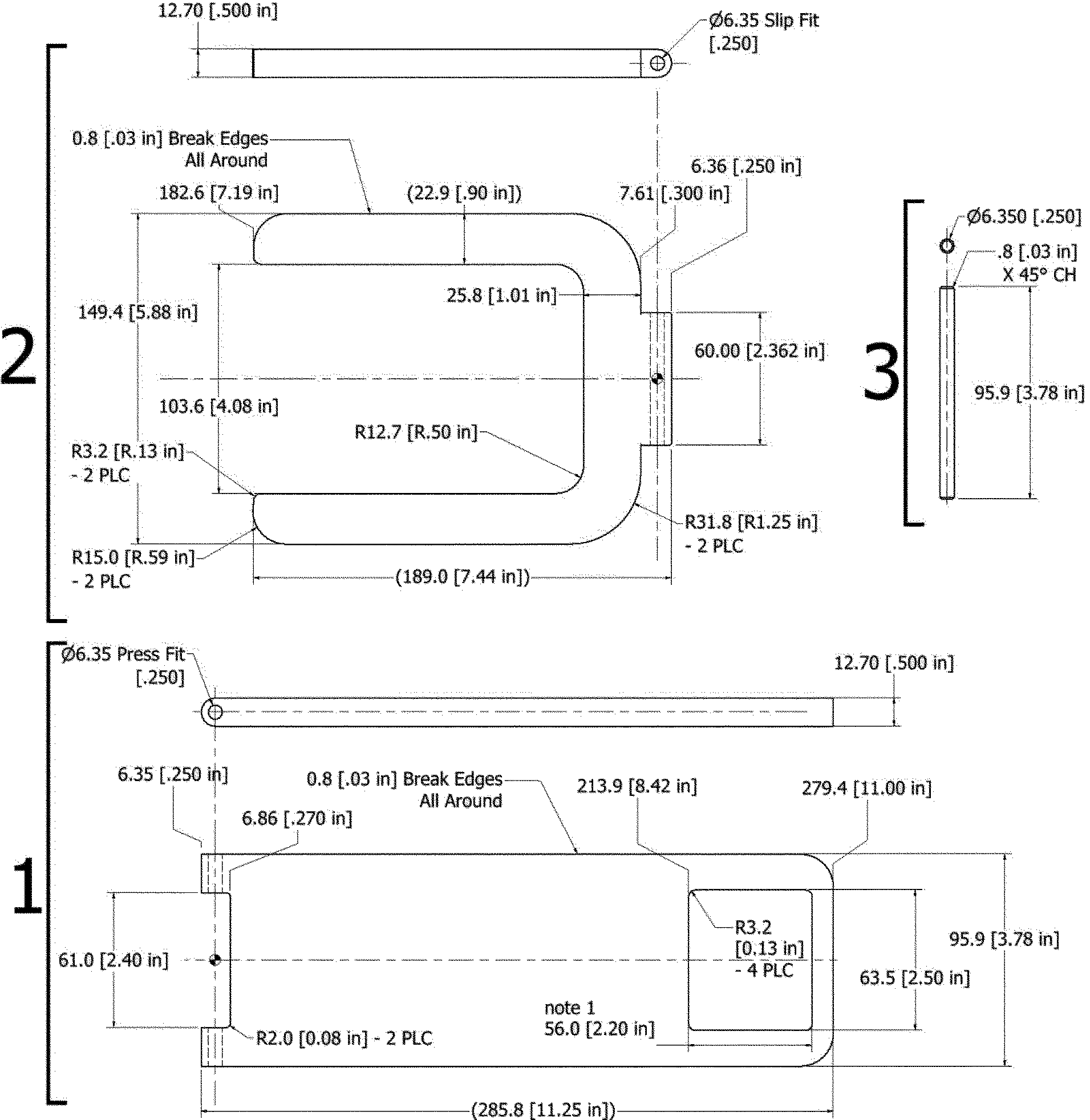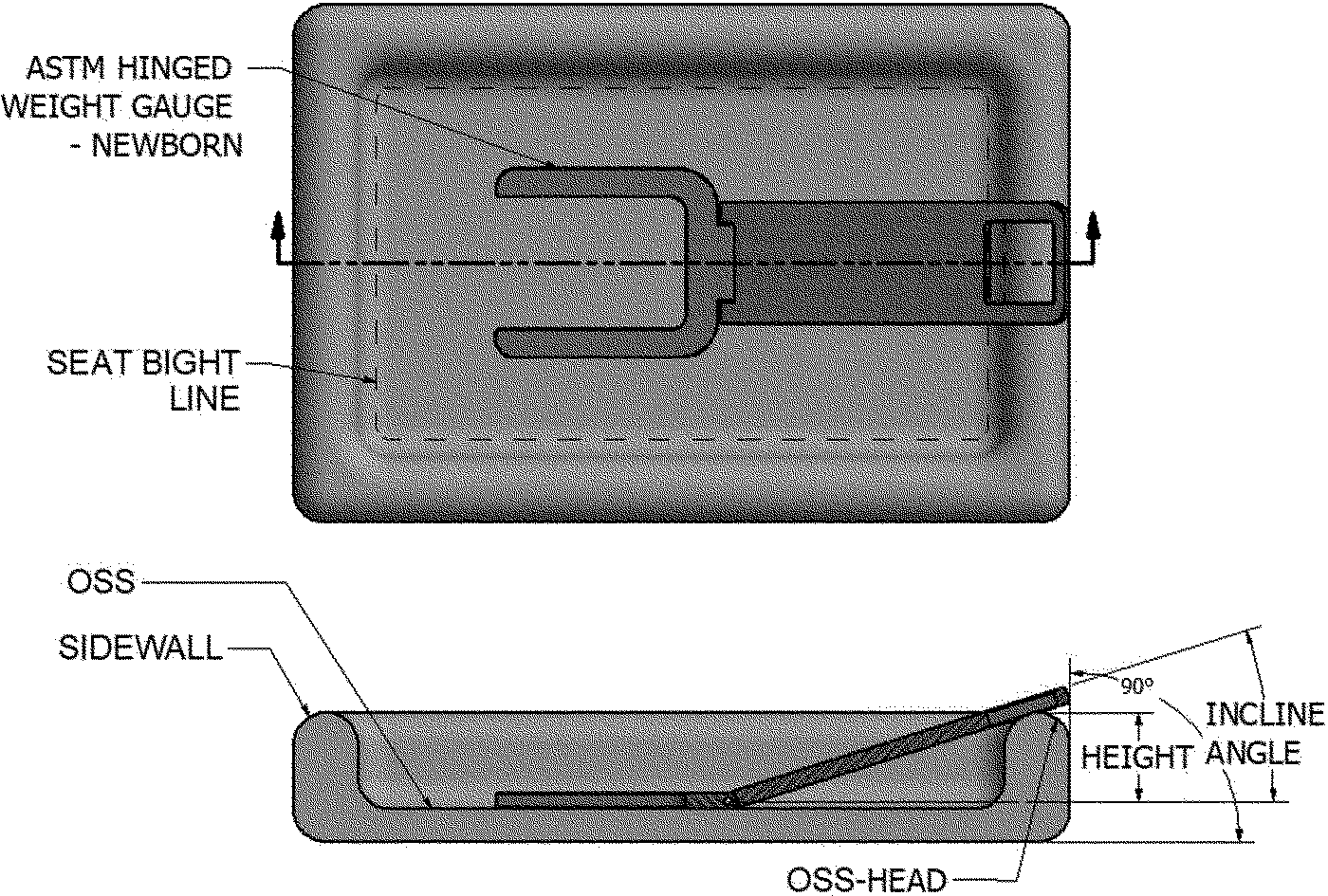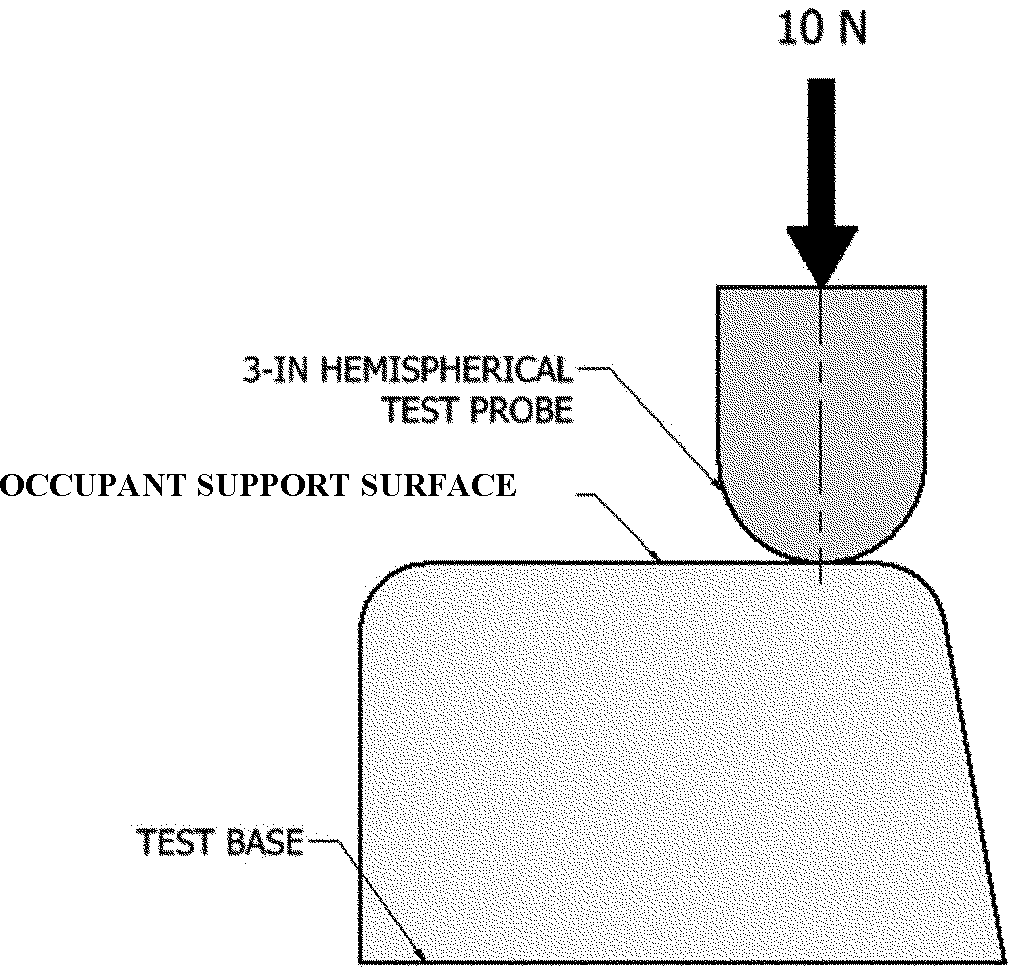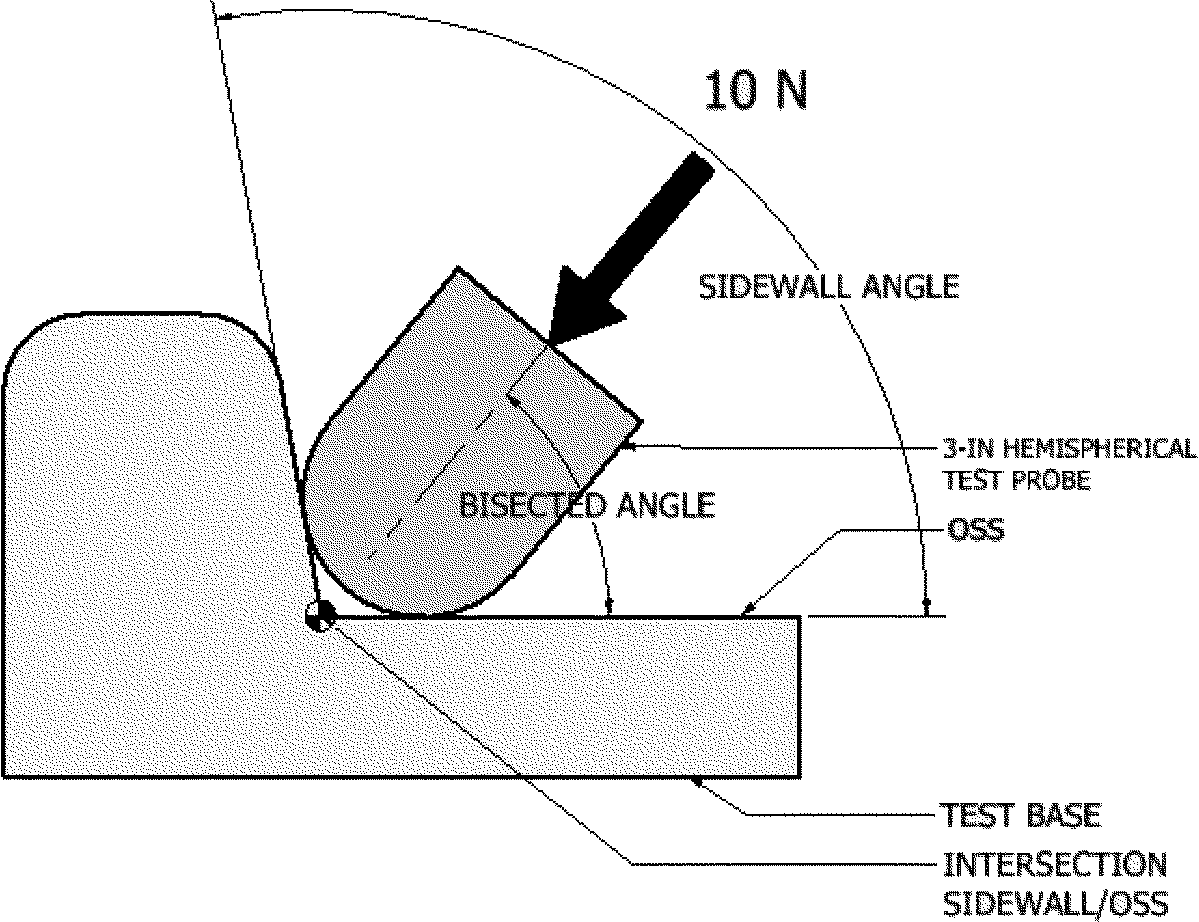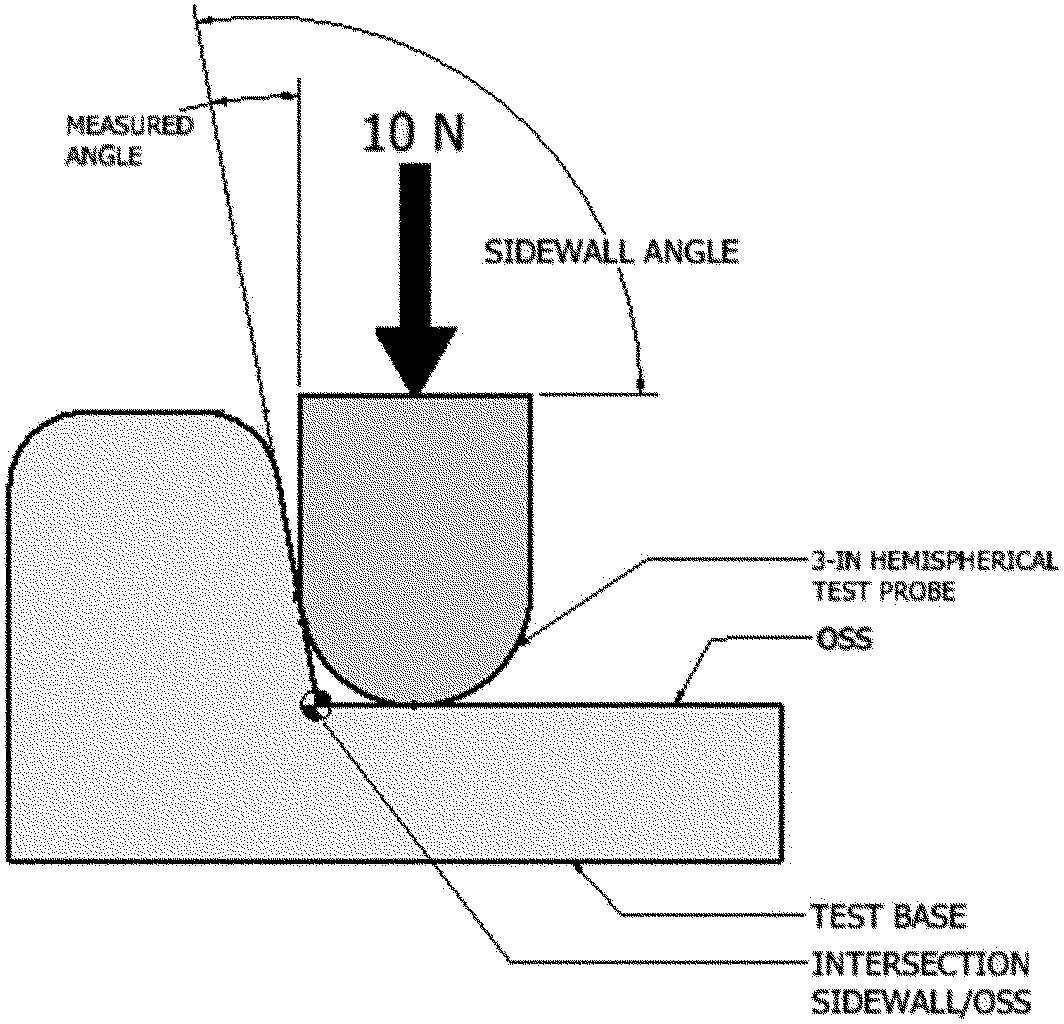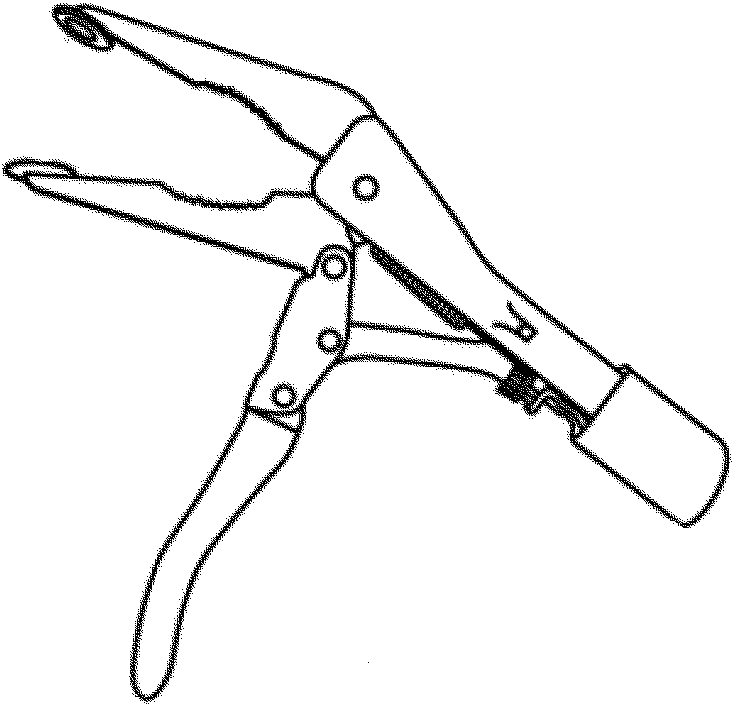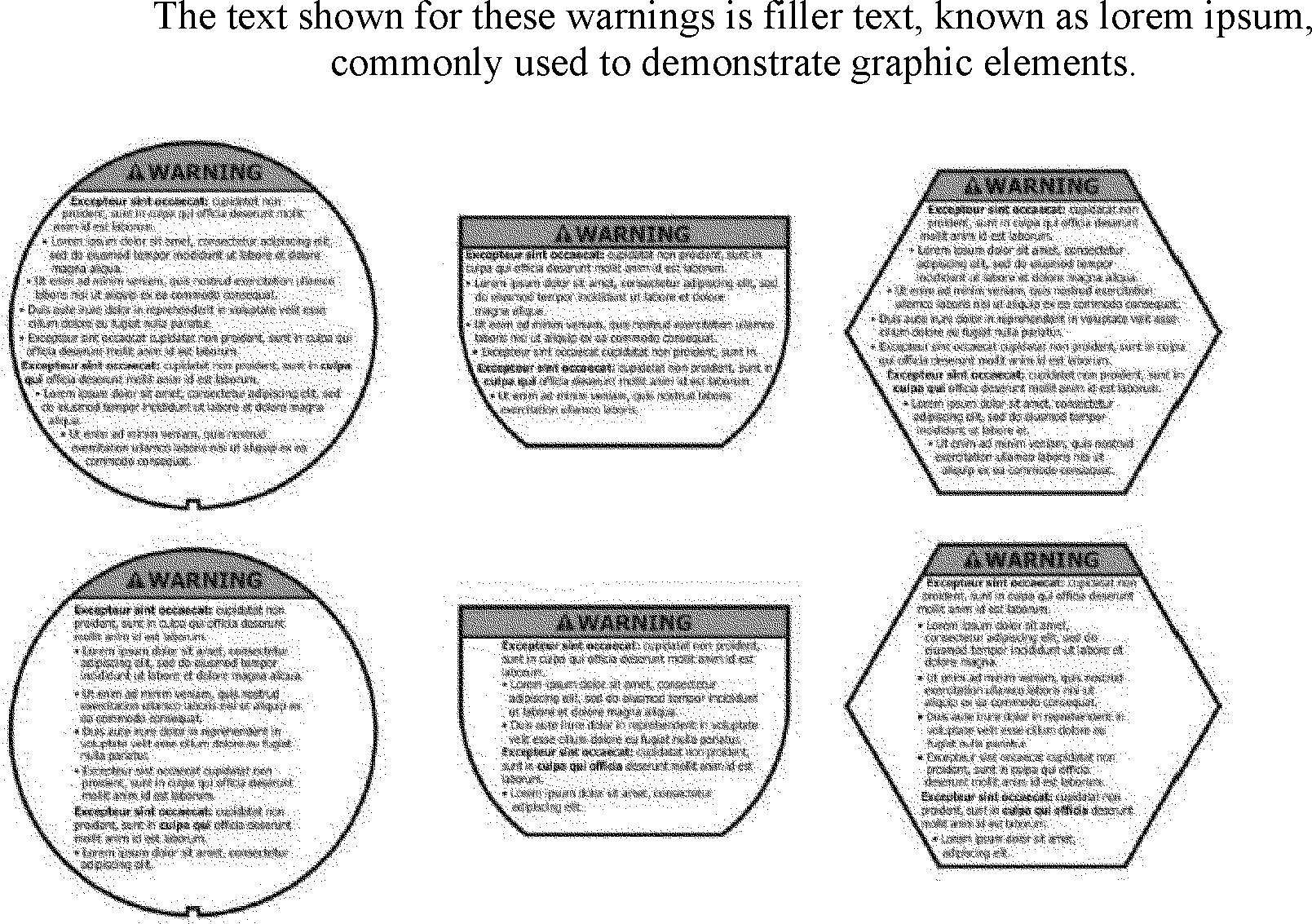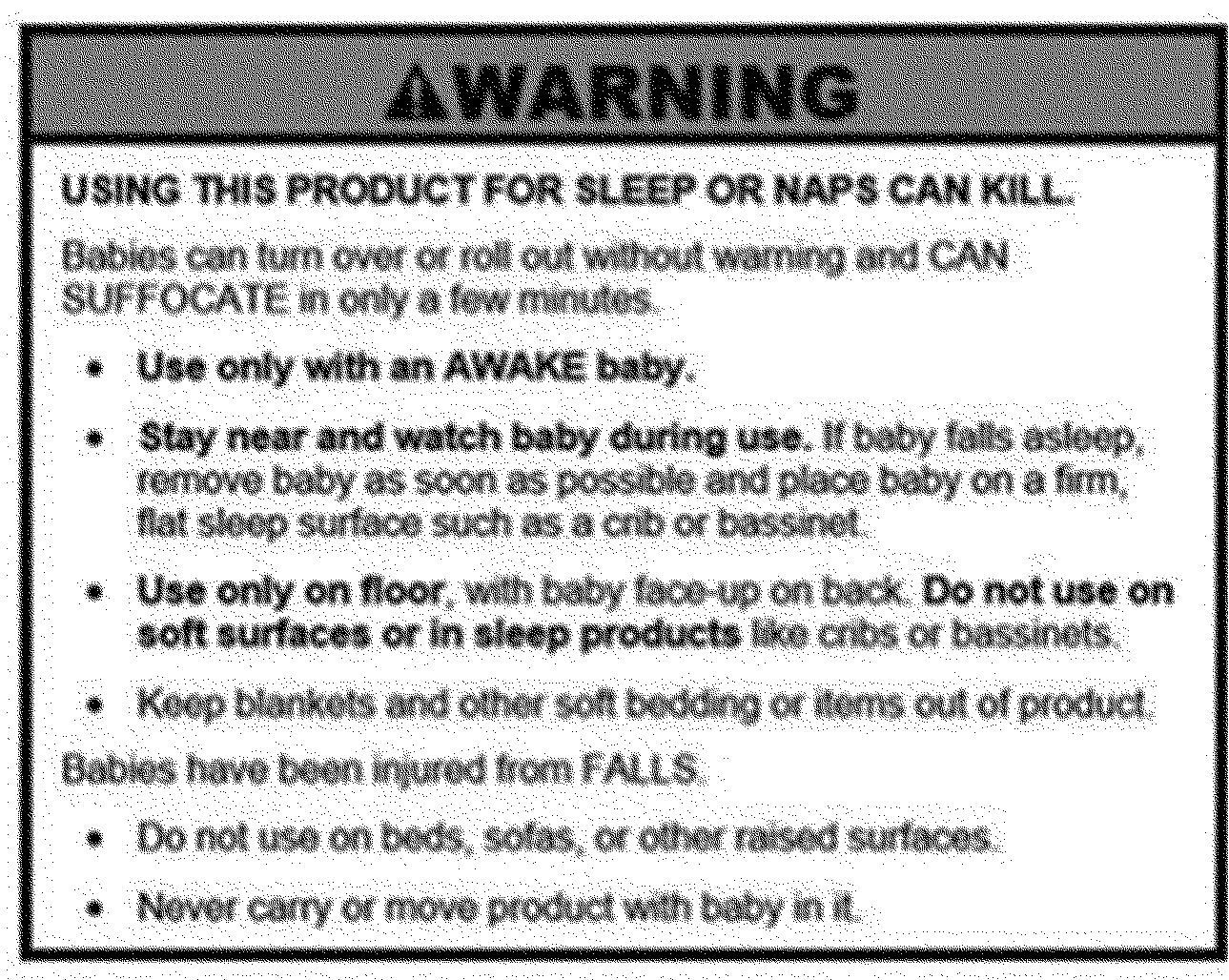-
Start Preamble
AGENCY:
Consumer Product Safety Commission.
ACTION:
Notice of proposed rulemaking.
SUMMARY:
The Danny Keysar Child Product Safety Notification Act, section 104 of the Consumer Product Safety Improvement Act of 2008 (CPSIA), requires the U.S. Consumer Product Safety Commission (Commission or CPSC) to promulgate consumer product safety standards for durable infant or toddler products. Under this statutory direction, the Commission is proposing a safety standard for infant support cushions. The Commission is also proposing to amend CPSC's consumer registration requirements to identify infant support cushions as durable infant or toddler products and proposing to amend CPSC's list of notices of requirements (NORs) to include infant support cushions.
DATES:
Submit comments by March 18, 2024.
ADDRESSES:
Comments related to the Paperwork Reduction Act aspects of the marking, labeling, and instructional literature requirements of the proposed rule should be directed to the Office of Information and Regulatory Affairs, Office of Management and Budget, Attn: CPSC Desk Officer, FAX: 202–395–6974, or emailed to oira_submission@omb.eop.gov.
Other comments, identified by Docket No. CPSC–2023–0047, may be submitted electronically or in writing, as follows:
Electronic Submissions: Submit electronic comments to the Federal eRulemaking Portal at: https://www.regulations.gov. Follow the instructions for submitting comments. Do not submit through this website: confidential business information, trade secret information, or other sensitive or protected information that you do not want to be available to the public. CPSC typically does not accept comments submitted by email, except as described below.
Mail/Hand Delivery/Courier/Confidential Written Submissions: CPSC encourages you to submit electronic comments by using the Federal eRulemaking Portal. You may, however, submit comments by mail, hand delivery, or courier to: Office of the Secretary, Consumer Product Safety Commission, 4330 East West Highway, Bethesda, MD 20814; telephone: (301) 504–7479.
Instructions: All submissions received must include the agency name and docket number for this proposed rulemaking. CPSC may post all comments without change, including any personal identifiers, contact information, or other personal information provided, to: www.regulations.gov. If you wish to submit confidential business information, trade secret information, or other sensitive or protected information that you do not want to be available to the public, you may submit such comments by mail, hand delivery, or courier, or you may email them to: cpsc-os@cpsc.gov.
Docket: For access to the docket to read background documents or comments received, go to: https://www.regulations.gov, insert the docket number, CPSC–2023–0047, into the “Search” box, and follow the prompts.
Start Further InfoFOR FURTHER INFORMATION CONTACT:
Stefanie Marques, Ph.D., Project Manager, Directorate for Health Sciences, U.S. Consumer Product Safety Commission, 5 Research Place, Rockville, MD 20850; email: smarques@cpsc.gov; telephone: (301) 987–2581.
End Further Info End Preamble Start Supplemental InformationSUPPLEMENTARY INFORMATION:
I. Background and Statutory Authority
Section 104(b) of the CPSIA requires the Commission to (1) examine and assess the effectiveness of voluntary consumer product safety standards for durable infant or toddler products, in consultation with representatives of consumer groups, juvenile product manufacturers, and independent child product engineers and experts and (2) promulgate consumer product safety standards for durable infant and toddler products. 15 U.S.C. 2056a(b)(1). The Commission must continue to promulgate standards for all categories of durable infant or toddler products “until the Commission has promulgated standards for all such product categories.” 15 U.S.C. 2056a(b)(2).
The Commission is issuing this notice of proposed rulemaking (NPR) to establish a consumer product safety rule for infant support cushions to further implement section 104 of the CPSIA.[1] The proposed rule defines an “infant support cushion” as “an infant product that is filled with or comprised of resilient material such as foam, fibrous batting, or granular material or with a gel, liquid, or gas, and which is marketed, designed, or intended to support an infant's weight or any portion of an infant while reclining or in a supine, prone, or recumbent position.” This includes infant pillows, infant loungers, nursing pillows with a lounging function, infant props or cushions used to support an infant for activities such as “tummy time,” and other similar products.
CPSC staff identified at least 79 reported fatalities involving infant support cushions from January 1, 2010, through December 31, 2022, as well as 125 nonfatal incidents or reports involving these products within the same time period. There were 17 deaths in 2020, and at least 17 more in the potentially incomplete data from 2021. More than 80 percent of the fatalities associated with these products involved infants three months old and younger. In more than 60 percent of the fatalities, the official cause of death was either asphyxia or probable asphyxia, and these incidents typically involved use of an infant support cushion placed in or on a sleep-related consumer product such as an adult bed, futon, crib, bassinet, play yard, or a on a couch. For the nonfatal incidents, the most common circumstances involved an infant falling from an infant support cushion placed on a raised surface such as a bed or a sofa or the threat of asphyxia or entrapment.
This proposed rule addresses the risk of death and injury associated with Start Printed Page 2531 infant support cushions primarily due to suffocation, entrapment, and fall hazards. The proposed rule would address positional asphyxiation hazards by requiring that all surfaces be sufficiently firm that they are unlikely to conform to an infant's face and occlude the airways, and by setting a maximum incline angle that would prevent hazardous positioning of an infant's head and neck along the surfaces of the product. The proposed rule would set a side angle requirement that addresses the risk of entrapment between the sidewall and the occupant support surface. It addresses fall hazards by effectively limiting sidewall height to discourage caregivers from mistakenly believing these products to be safe for unattended infants. The proposed rule also requires a strongly worded, conspicuous, and permanent on-product warning.
Consistent with section 104(b)(1)(A) of the CPSIA, CPSC consulted with manufacturers, retailers, trade organizations, laboratories, consumer advocacy groups, consultants, and the public to develop this rule, including through participation in the juvenile products subcommittee meetings of ASTM.[2] Currently, however, no voluntary or mandatory safety standard for infant support cushions exists to address the hazards posed by these products.
Infant support cushions are a durable infant or toddler product under section 104(f) of the CPSIA. Section 104(f)(1) defines the term “durable infant or toddler product” as “a durable product intended for use, or that may be reasonably expected to be used, by children under the age of 5 years.” 15 U.S.C. 2056a(f)(1). Section 104(f)(2) of the CPSIA provides a non-exhaustive list of product categories within the definition of “durable infant or toddler products.” Although infant support cushions are not specifically listed in section 104(f)(2), they are “durable infant or toddler products” because (as explained in Part II, below) they are: not disposable; have a useful life of up to several years and often are used by multiple children successively; are similar to other durable infant and children's products such as crib mattresses and sling carriers; and are primarily intended to be used by children five years old or younger.
Section 104(d) of the CPSIA requires manufacturers of durable infant or toddler products to establish a product registration program and comply with CPSC's rule for product registration cards, 16 CFR part 1130. The Commission proposes to amend part 1130 to include infant support cushions in the list of durable infant or toddler products that must comply with these product registration requirements. See16 CFR 1130.2(a).
Manufacturers of children's products also must comply with product registration requirements, as well as testing and certification requirements for children's products that are codified in 16 CFR parts 1107 and 1109. Section 14(a)(3) of the Consumer Product Safety Act (CPSA) requires the Commission to publish an NOR for the accreditation of third party conformity assessment bodies (test laboratories) to assess conformity with a children's product safety rule to which a children's product is subject. The proposed rule would be a children's product safety rule that requires issuance of an NOR.
II. The Product Category
A. Infant Support Cushions
Infant support cushions include products that support an infant for lounging, meaning reclining or lying in a supine, prone, or recumbent position. Infant products within this category may or may not contain infants with perimeter walls. Most infant support cushions on the market today are filled with cushy foam or soft fibrous batting, covered by flexible fabric. Some infant support cushions are marketed for use in a crib or other infant sleep product, notwithstanding warnings from the Commission and others, including the American Academy of Pediatrics (AAP), that soft objects, such as pillows and excess bedding, should not be placed in an infant's sleep environment.
Illustrative pictures of infant support cushions can be found in Tab C of staff's briefing package for this proposed rule.[3] A non-exhaustive list of examples of infant support cushions includes:
- head positioner pillows;
- flat baby loungers;
- crib pillows;
- wedge pillows for infants;
- infant sleep positioners, unless regulated by the Food and Drug Administration (FDA) as medical devices;
- stuffed toys marketed for use as an infant support cushion;
- infant “tummy time” or “lounging” pillows, whether flat or inclined;
- multi-purpose pillows marketed for both nursing and lounging;
- anti-rollover pillows with or without straps that fasten the pillow to the infant;
- infant “self-feeding” pillows that hold a bottle in front of the face of a reclining or lying infant;
- pads and mats; and
- accessory pillows and other padded accessories, often marketed for use with an infant car seat, stroller, or bouncer, but not sold with that product and therefore not included in the mandatory safety standard for those products.
These in-scope products would be required to meet the performance standards of this rule. To avoid potentially duplicative or conflicting obligations, however, the scope of products that would be subject to this proposed rule does not include durable infant products that are already regulated by the Commission and included in the list of products at 16 CFR 1130.2(a).
Illustratively, the following products are not infant support cushions within the scope of this proposed rule:
- Pillows not marketed or intended for use by infants, such as adult bed and throw pillows;
- nursing pillows if subject to Commission's proposed nursing pillow rule 88 FR 65865 (Sept. 26, 2023) if that rule is finalized, unless they are also marketed for lounging;
- crib and play yard mattresses that are in scope of the play yard and crib mattress standard in 16 CFR part 1241;
- purely decorative nursery pillows, such as those personalized with a baby's name and birthdate, that are not for infant use;
- stuffed toys (unless they meet the definition of an infant support cushion in this proposed rule);
- padded seat liners that are sold with a rocker, stroller, car seat, infant carrier, swing, highchair, or bouncer that are specifically designed to fit that product; and
- sleeping accommodations, which are regulated under the Commission's infant sleep product rule at 16 CFR part 1236.
B. Market Description
Most types of new infant support cushions are sold online, including from Start Printed Page 2532 general online retailers, online sites for “big box” stores, online baby products sites, and online marketplaces for hand-crafted items. A few types of infant support cushions, however, are also available from brick-and-mortar baby specialty stores and general retail stores, particularly crib pillows and baby loungers. Prices for new infant support cushions average roughly $30 and range from less than $15 for a simple head positioner pillow or crib pillow to more than $250 for a lounger with a removable cover or a large stuffed toy marketed for sleep. Several thousand manufacturers and importers, including hundreds of handcrafters and direct foreign shippers, supply infant support cushions to the U.S. market. See Staff's NPR Briefing Package, Tab E.
Infant support cushions may be re-used for multiple children or sold for use after an infant outgrows the product. Commission staff observed that used infant support cushions are widely available on secondary marketplaces such as eBay and Mercari. In June 2023, for example, staff found listings on Mercari for used changing pads, large stuffed toys marketed for infant sleep, crib wedge pillows, baby neck pillows, baby sleep positioners, baby loungers, baby sleep mats, baby “pillow chairs,” infant “self-feeding” pillows, baby/toddler bean bag chairs, and crib pillows.
C. Infant Cushion/Pillow Ban
In 1992, pursuant to the Commission's authority under the Federal Hazardous Substances Act (FHSA), 15 U.S.C. 1261–1278, the Commission issued a ban on certain infant cushions and pillows filled with foam, plastic beads, or other granular material. 57 FR 27912 (June 23, 1992). That ban prohibits “infant cushions,” “infant pillows,” and similar articles that are:
- made with a flexible fabric covering;
- loosely filled with granular material, including but not limited to, polystyrene beads or pellets;
- easily flattened;
- capable of conforming to the body or face of an infant; and
- intended or promoted for use by children under one year of age.
16 CFR 1500.18(a)(16). This proposed rule for infant support cushions does not change the FHSA ban. That ban was limited to products with the specific hazard presented by loosely filled granular material such as polystyrene beads or pellets, and those products will continue to be banned under the FHSA. Infant support cushions that are not subject to the ban are within the scope of this proposed rule and would be required to comply with the performance requirements of this proposed rule.[4]
III. Incident Data and Hazard Patterns
CPSC staff searched the Consumer Product Safety Risk Management System (CPSRMS) [5] and National Electronic Injury Surveillance System (NEISS) [6] databases for fatalities, incidents, and concerns associated with infant support cushions and involving infants up to 12 months old, reported to have occurred between January 1, 2010, and December 31, 2022. Tab A of Staff's NPR Briefing Package describes the incident and hazard patterns associated with infant support cushions.
Commission staff identified 79 fatal incidents and 125 nonfatal incidents and consumer concerns reported to CPSC from 2010–2022. Of the 125 non-fatal reports. 22 consisted of emergency-department-treated injuries, three involved hospital admissions, 46 reports involved no injury, and for 52 reports the disposition was either unknown or unspecified. Table 1 provides the distribution of fatal incidents by year.
Start Printed Page 2533Table 2 summarizes the number of reported fatalities related to infant support cushions for victims 12 months and younger by age in months and by gender. As reflected in Table 2, 80 percent of the fatalities with a known age were infants in the zero to three month age range. Among the 76 fatalities for which the sex is known, half were male and half were female.
Table 2—Infant Support Cushion-Related Fatalities for Victims Ages 12 Months and Younger and Sex: 2010–2022
Age (In months) Total (% of total) Male (% of total) Female (% of total) Unknown (% of total) Total 79 (100%) 38 (48%) 38 (48%) 3 (4%) 1 26 (33%) 12 (15%) 14 (18%) 0 2 19 (24%) 10 (13%) 9 (11%) 0 3 18 (23%) 8 (10%) 10 (13%) 0 4 7 (9%) 4 (5%) 3 (4%) 0 5 3 (4%) 1 (1%) 0 2 (3%) 6 1 (1%) 0 1 (1%) 0 7 2 (3%) 1 (1%) 1 (1%) 0 8 0 0 0 0 9 0 0 0 0 10 1 (1%) 1 (1%) 0 0 11 1 (1%) 1 (1%) 0 0 12 0 0 0 0 Unknown 1 (1%) 0 0 1 (1%) Source: CPSRMS and NEISS databases. Percentages may not add to 100 due to rounding; the years 2021–2022 are considered incomplete. The official cause of death reported by the medical examiner in the majority of the 79 reported fatalities 49 (62 percent) was asphyxia or probable asphyxia; 13 (17 percent) were determined to be due to sudden unexpected infant death (SUID) events; 12 (15 percent) had an undetermined cause of death; and for five (six percent), no medical examiner's report was available. Nearly all reported fatalities (75 of 79) involved placement of the infant support cushion on another sleep-related consumer product. For the remaining four fatalities, the placement of the infant support cushion was either undetermined or unknown.
In the 125 nonfatal incidents associated with infant support cushions that involved children ages 12 months and younger and occurred between January 1, 2010, and December 31, 2022, three infants were admitted to the hospital and 22 infants were reported to have been treated and released from an emergency department. In 52 of these nonfatal incidents, the severity of the injury was unspecified or unknown, and in 46 of the incidents no injury was reported. Table 3 summarizes the disposition of the nonfatal incident reports associated with infant support cushions and victims ages 12 months and younger. Start Printed Page 2534
Table 3—Infant Support Cushion-Related Nonfatal Reports by Severity for Victims Ages 12 Months and Younger: 2010–2022
Severity Total reports (% of total) Total Non-Fatal Reports 125 (100%) Hospital Admissions 3 (2%) Emergency Department Treated 22 (18%) Left without being seen 1 (1%) Seen by a Medical Professional 1 (1%) Unspecified/Unknown 52 (42%) No Injury Reported 46 (37%) Source: CPSRMS and NEISS databases. Percentages may not add to 100 due to rounding; the years 2021–2022 are considered incomplete. For the 46 reports for which no injury was reported, many of the descriptions in the incident reports indicated the potential for serious injury or death. Staff's analysis of the narratives associated with these incident reports indicated that in 29 reports (23 percent) of the incidents, an infant support cushion occupied by an infant had been place on an elevated surface (such as an adult bed or couch) and the infant had fallen off; 27 (22 percent) specified threatened asphyxia; and 17 incidents (14 percent) involved various types of rashes caused by the product. Table 4 summarizes the hazard patterns for infant support cushion-related nonfatal incidents.
Table 4—Infant Support Cushion-Related Non-Fatal Reports by Hazard Pattern for Victims Ages 12 Months and Younger: 2010–2022
Event Number of non-fatal reports (% of total) Children (0 to 12 months) Fall 29 (23%) Threatened Asphyxia 27 (22%) Rash 17 (14%) Limb Entrapment 1 (1%) Mold 1 (1%) Choking 1 (1%) Near Strangulation 1 (1%) Vomiting 1 (1%) Consumer Complaints 47 (38%) Total Non-Fatal Reports 125 (100%) Source: CPSRMS and NEISS databases. Percentages may not add to 100 due to rounding; the years 2021–2022 are considered incomplete. Staff, based on review of nonfatal incident and report data, identified falls and threatened asphyxia as the two major nonfatal hazard patterns associated with infant support cushions. In the case of falls, the reports revealed that in most incidents infant support cushions had been placed on elevated surfaces including adult beds and couches. The injuries associated with falls include concussions, facial injuries, and scalp injuries.
In the case of threatened asphyxia, the narratives described scenarios of infants being rescued after being found hanging partially or completely off of the infant support cushion with their mouths and noses obstructed, with their heads wedged between sleep positioner side cushions, or having rolled to a face-down position that put them at risk of an obstructed airway.
IV. International Standards for Infant Support Cushions
The Commission is aware of two international standards, both British, that contain performance requirements that address suffocation and asphyxiation hazards associated with infant pillows. BS 1877–8:1974, Specification for Domestic bedding—Part 8: Pillows and bolsters for domestic use (excluding cellular rubber pillows and bolsters) (BS 1877–8:1974) and BS 4578:1970, Specification for Methods of test for hardness of, and for air flow through, infants' pillows (BS 4578:1970). The scope of BS 1877–8:1974 includes both adult and cot pillows (infant pillows), and recommends that cot pillows be filled firmly enough to prevent infants' heads from sinking into the products and that the pillow covering not be loose enough to be drawn into an infant's mouth. BS 1877–8:1974 has requirements for cot pillow size, filling, and covering. Cot pillows must be 58 x 38 cm (23 x 15 inches) and their covering must be of open construction to allow air permeability. Both the filling and covering must meet performance requirements described in BS 4578:1970 for “hardness” ( i.e., firmness) and air permeability.
The hardness test in BS 4578:1970 requires that a 100 mm diameter probe be placed in the center of the product with 10 newtons (N) of force for one minute. BS 1877–8:1974 requires that displacement of the pillow when the force is applied shall not exceed 25 percent of the thickness. Staff assesses that the proportional approach used in this standard allows thicker pillows to have a greater displacement than thinner pillows, which does not sufficiently protect against the suffocation and asphyxia hazards associated with infant support cushions because that greater displacement could allow the product to obstruct the infant's airways.
V. Boise State University Contractor Report
CPSC awarded a contract to Boise State University (BSU) for infant biomechanics and suffocation research and consultancy services. This research included an analysis of the risk of injury or death to infants associated with the use of nursing pillows and infant support cushions during activities such as feeding, nursing, sleeping, propping, and lounging. See Staff's NPR Briefing Package, Tab C.
BSU delivered its final report on June 30, 2022 (the BSU Final Report).[7] The BSU Final Report provides recommendations and conclusions related to the performance and design of infant support cushions, including the following.
Firmness Testing. The BSU Final Report recommends that all infant support cushions be required to undergo firmness testing because products that lack firmness are more likely to conform around an infant's nose and mouth and present a suffocation hazard. The report recommended testing all infant pillows for firmness using a three-inch diameter, anthropometry-based hemispheric probe that is geometrically similar to, and sized to represent the breadth of, an infant's face. The report recommends that the probe should be applied to the product at three locations: the location of maximum thickness, the location of minimum thickness, and a subjective location of interest ( i.e., another soft location most likely to result in failure). The force required to displace the probe one inch into the product at each location must exceed 10 N. Meeting this requirement would mean that the product has firmness comparable to crib mattresses.
Airflow Testing. The BSU Final Report recommends that products that do not pass firmness testing be required to pass an airflow test. Passing the airflow test would mean that the product has airflow characteristics comparable to current mesh crib liners, which the BSU researchers concluded would mitigate the suffocation hazard. However, the report recommends against requiring that airflow testing for products that pass the BSU Final Start Printed Page 2535 Report's proposed firmness testing, because a firm product is unlikely to form a seal around an infant's nose and mouth.
Sagittal-Plane Testing. BSU developed prototype sagittal-plane testing devices to allow for more comprehensive assessments of infant positioning in and on infant support cushions.[8] The BSU Final Report recommends further research to determine appropriate worst-case positions for testing and to set threshold values for acceptable body positions that would not negatively impact infant breathing.
Tab C of Staff's NPR Briefing Package contains staff's summary of how the Commission's proposed rule reflects the conclusions and recommendations of the BSU Final Report.
VI. ASTM's Working Draft Standard
There are no published U.S. voluntary standards for infant support cushions. ASTM is working toward a voluntary standard for infant loungers under Subcommittee F15.21 on Infant Carriers, Bouncers, and Baby Swings.[9] In the draft voluntary standard, an “infant lounger” is a product “with a raised perimeter, a recess, or other area that is intended to be placed on the floor and to provide a place for an infant to sit, lie, recline, or rest, while supervised by an adult.” That draft definition would govern only a subset of the products covered by this proposed rule, which includes infant positioners, nursing products with dual use for lounging, infant cushions, and other infant pillow-like products, as well as the infant loungers being considered by ASTM. Staff has been working with ASTM to develop performance requirements intended to address the primary hazards associated with infant loungers, but to date ASTM has not issued a ballot on a standard for infant loungers.
ASTM's draft voluntary standard includes general requirements typically found in other ASTM juvenile product standards, such as requirements addressing lead content, small parts, hazardous sharp edges or points, and toy accessories that are attached to, removable from, or sold with the products. The ASTM draft also specifies that if the lounger can be converted to another product it shall comply with the applicable requirements of that product's standard. The general requirements of the draft infant lounger standard also state that the sidewall height of the product shall be less than four inches when measured according to the sidewall height measurement test method specified in the draft standard. The draft voluntary standard further includes the following performance requirements:
• Stability: The product shall not tip over and shall retain the CAMI dummy [10] when tested in all manufacturers' use positions.
• Infant Restraints: The product shall not have a restraint system.
• Fabric/Mesh Integrity: This requirement is intended to address product integrity issues such as seam failures and material breakage.
• Bounded Openings: This requirement is intended to address potential entrapment hazards associated with openings in the product.
• Occupant Support Surface: This requirement is intended to address the thickness of, dimensions of, and potential gaps in the occupant support surface.
• Occupant Support Surface Firmness: This requirement uses an eight-inch diameter, disc-shaped “firmometer” probe and requires that there shall be no point where the feeler arm of the device, which hangs over the edge of a disc, comes in contact with the occupant support surface.
• Sidewall Firmness: The top of the sides of the product cannot be displaced more than one inch when a three-inch diameter hemispheric probe is applied to the product with 10 N of force.
• Side Angle and Deflection: To address potential entrapment hazards at the intersection of the side wall and occupant support surface, the angle between the sidewall and the occupant support surface of the infant support cushion shall be greater than 90 degrees.
The draft voluntary standard also includes marking, labeling, and instructional literature requirements, such as warning the consumer on the product about not using the product for sleep or naps, only using the product when the occupant baby is supervised, only using the product on the floor, keeping soft bedding out of the product, not using the product on raised surfaces, and not using the product to carry or move an infant. The draft standard requires the warnings to be “permanent” and “conspicuous.”
The product's instructions must, among other requirements, indicate the manufacturer's recommended maximum weight, height, age, developmental level, or combination of these attributes for any infant using the product, as well as any limitation on use of the product by a child for any specific unintended use.
VII. Description of the Proposed Mandatory Standard for Infant Support Cushions 11
To address established risks of death and injury associated with infant suffocations, asphyxiations, entrapments, and falls, and as section 104 of the CPSIA requires, the Commission is issuing this proposed rule to establish mandatory performance and labeling requirements for infant support cushions.
The text of the proposed rule is based on an evaluation of incident data associated with infant support cushions, the ASTM working draft standard for infant loungers that is under development, and the recommendations of the BSU Final Report. The proposed rule is summarized below and explained in more detail in Tabs C and F of Staff's NPR Briefing Package.
A. Scope and Definitions
Section 1243.1 of the proposed rule explains that the rule would apply to infant support cushions, including infant positioners, nursing products with a dual use for lounging, infant loungers, infant props, or cushions used to support an infant for activities such as “tummy time,” and other infant pillow-like products. It would exclude, however, products already regulated by other Commission mandatory standards for durable infant products, which are listed in 16 CFR 1130.2(a). The proposed rule would apply to all infant support cushions manufactured after the effective date of the rule.
Section 1243.2 of the proposed rule defines “infant support cushion” as “an infant product that is filled with or comprised of resilient material such as foam, fibrous batting, or granular material or with a gel, liquid, or gas, and which is marketed, designed, or intended to support an infant's weight or any portion of an infant while reclining or in a supine, prone, or recumbent position.”
The scope of “infant support cushions” is intended to encompass the products described in Part II above.
As noted previously, this proposed definition of “infant support cushions” includes, but is not limited to, the infant Start Printed Page 2536 loungers that would be subject to ASTM's draft voluntary standard. The proposed rule would define “infant lounger” as “an infant product with a raised perimeter, a recess, or other area that provides a place for an infant to recline or to be in a supine, prone, or recumbent position.” Because, however, incident data show that the suffocation, asphyxiation, and fall hazards this rule seeks to address are posed by other infant pillow-like products, in addition to those with a raised perimeter or recess, the proposed broader definition more effectively addresses the hazards posed by these products. For example, the proposed rule would apply to “infant positioners,” defined as a product intended to help keep an infant in a particular position while supine or prone.
As discussed above, ASTM is working concurrently on developing voluntary standards for both “infant feeding supports” and “infant loungers.” The draft ASTM standards address hazards posed by “dual use” products intended to be used both to feed an infant and to support a lounging infant by requiring such products to comply with both standards. Adopting ASTM's approach, the proposed rule would apply to nursing pillows with a dual use for lounging, while excluding those nursing pillows that are solely intended to be used for nursing or feeding, along with other products already regulated by other Commission mandatory standards for durable infant products.
The Commission invites public comment on the scope of the proposed rule, including whether it addresses all products that pose the identified hazards and whether it is sufficiently clear and administrable. For example, the Commission invites public comment on whether it is appropriate to subject “dual use” products to both the proposed nursing pillow rule and the proposed infant support cushion rule (assuming that both are finalized), and what nursing products should be considered “dual use.”
B. General Requirements
The proposed rule includes many of the general requirements included in the ASTM draft standard for infant loungers to address sharp edges or points, small parts, and lead in paints. It also requires that toy accessories that are attached to, removable from, or sold with the products comply with 16 CFR part 1250, which establishes a mandatory safety standard for toys, as well as requirements for the permanency of labels and warnings. However, while ASTM's draft standard for infant loungers would allow a maximum sidewall height of four inches, the Commission is concerned that this height may give consumers the mistaken impression that an infant can safely be left unattended in or on the product. For that reason, the proposed rule addresses the positional asphyxia hazard with a maximum incline requirement that effectively sets a lower limit on sidewall height, rather than the maximum side height requirement currently favored by ASTM. The Commission invites public comment on side height limit and incline angle requirements.
C. Proposed Performance Requirements
1. Firmness
The Commission's proposed firmness requirements and associated test methods are consistent with those applicable to crib mattresses and more stringent than those currently included in ASTM's draft standard for infant loungers. As explained in Tab C of Staff's NPR Briefing Package, based upon the findings and recommendations in the BSU Final Report as well as staff's analysis of the incidents and hazard patterns associated with facial occlusion into infant support cushions, the proposed rule requires firmness testing at three locations: the occupant support surface, the sidewall, and the intersection of the occupant support surface with the sidewall, as follows:
a. Occupant Support Surface (OSS) Firmness
The proposed rule includes a firmness test for the occupant support surface [12] that is based on the BSU Final Report, with modifications to improve the test methodology. The firmness test is intended to reduce the likelihood that the OSS can conform to an infant's face and cause suffocation. The proposed rule requires that OSS firmness be tested using the three-inch diameter hemispheric probe developed by BSU, rather than the eight-inch firmometer probe in the ASTM draft standard. The three-inch probe is more consistent, in both size and shape, with the size and dimensions of an infant's head, enabling it to more accurately detect any material deformations and surface features that an infant's face may come in contact with on an infant support cushion. In addition, staff's testing showed that an eight-inch disc probe may not be as accurate as a three-inch hemispheric probe when used on certain models of infant support cushions with smaller dimensions or an OSS surface that is not completely flat, so that the eight-inch firmometer cannot fit well enough in the product to provide accurate measurement.
To meet the proposed rule's firmness requirement, the force required to displace the probe one inch into the OSS test location (as well as the two other test locations) must exceed 10 N (about 2.25 pounds), which indicates product firmness that is at least comparable to a crib mattress. Figure 1, below, illustrates the firmness test being applied to the OSS of an infant support cushion.
Start Printed Page 2537Because an infant's head or face may rest on the sidewall of a product, as well as on the product's OSS, the proposed rule includes firmness requirements for any product sidewall. While the ASTM working draft also requires firmness testing of sidewalls, the proposed rule requires testing a minimum of four sidewall locations, including the location of maximum sidewall height, and requires that the test locations include at least one location most likely to fail, rather than requiring that sidewalls be tested in six-inch increments around the product as stated in ASTM's draft. The differences from ASTM in testing protocol are intended to provide more accurate testing for both smaller head pillows and larger lounger products.
b. Intersection of OSS With Sidewall
To address the hazard of suffocation when an infant's face is surrounded on two sides by the OSS and a sidewall, the proposed rule includes firmness requirements based on testing the angle at which the two surfaces intersect, to ensure sufficient firmness to prevent the product from conforming to the infant's mouth or face and obstructing airways. It requires testing of firmness with the three-inch hemispherical probe positioned to bisect the angle formed where the two surfaces intersect, as shown in Figure 2.
Start Printed Page 2538The proposed rule's firmness requirements for the OSS/Sidewall intersection are similar to those in ASTM's draft standard.
2. Sidewall Angle
The proposed rule, like ASTM's draft, requires that the angle formed between the product's OSS and any sidewall be greater than 90 degrees to reduce potential entrapment hazards between the sidewall and the occupant support surfaces. The proposed rule requires a slightly different methodology for measuring this angle than does ASTM's draft. While ASTM's draft requires that this angle be measured with a protractor or similar tool at four-inch intervals along the product's interior, the proposed rule specifies assessing this angle with the cylindrical side of the three-inch probe, with a 10 N force applied to the probe. The probe, which is designed to simulate the size and shape of an infant's head, is used to determine whether there is any contact between the sidewall and the probe's side when the “face” of the probe is pressed against the OSS/sidewall intersection. If there is such contact, indicating an entrapment risk, that indicates that the angle is less than 90 degrees and the product would fail. Conversely, if there is no contact between the sidewall and the side of the probe, the angle is greater than 90 degrees and the product meets this requirement.
3. Maximum Incline Angle
The proposed rule, like ASTM's draft, requires that any incline of the OSS of an infant support cushion not exceed 10 degrees. This requirement is consistent with incline test of CPSC's Safety Standard for Infant Sleep Products,16 CFR part 1236, and the ban of inclined sleepers for infants in the Safe Sleep for Babies Act, 15 U.S.C. 2057d, and similarly it addresses the hazards associated with inclined sleep products.
The proposed rule, however, differs from ASTM's maximum incline angle requirements and test procedures in order to improve test consistency across all infant support cushion products and to address additional locations of potential inclined lounging, reclining, and sleep. The three ways in which the proposed rule modifies ASTM's proposed testing protocol are: (1) setting a maximum incline angle that applies not only to all of a manufacturer's recommended use positions, but also to all other infant cushion surfaces that can feasibly support an infant's head, including, for example, the angle from any sidewall to the OSS or from the sidewall to the floor; (2) use of a newborn hinged weight gauge, rather than an infant gauge; and (3) positioning the gauge differently throughout testing. Figure 3 below, shows the use of a hinged weight gauge to measure the incline on an infant support cushion with a sidewall. The proposed rule requires use of a newborn hinged weight gauge, rather than the heavier infant gauge specified in the ASTM draft, because infant support cushions are commonly used for newborns, who are at higher risk of suffocation.
Start Printed Page 25394. Sidewall Height
The proposed rule limits the height of any sidewall of an infant support cushion, as does ASTM's draft. However, the proposed rule addresses the hazards associated with relatively high sidewalls in a manner that is more closely tailored to the hazards, and applies to all of the products that fall within the scope of the proposed rule. These hazards are that caregivers may judge that an infant support cushion with relatively high sidewalls can safely contain an infant without supervision and is suitable for use on top of an adult bed or in a crib notwithstanding any contrary warnings, and that high sidewalls can cause hazardous positioning of the infant's neck when an infant's head is placed on top of the sidewall while their body is on a lower surface either inside or outside of the product. See Staff's NPR Briefing Package, Tabs B and C. While ASTM's draft sets a four-inch limit on sidewall height, the proposed rule addresses these hazards by limiting the maximum incline angle and provides testing protocols based on the type of product (for example, lounger-type products or head cushions). Using the test methodology prescribed in the proposed rule, sidewall heights, for products that have sidewalls, would be limited to approximately 1.9 inches.
The Commission invites public comments on the proposed rule's method for addressing hazards posed by sidewall heights via measurement of maximum incline angle and what methodology would most effectively address the identified fall and positional asphyxia hazards.
D. Warning and Instructional Requirements
Compared to the performance requirements described above, warnings are less effective in eliminating or adequately reducing exposure to hazards associated with infant support cushions. Nevertheless, prominent and well-designed warnings can provide consumers with important information about the hazards associated with these products and appropriate behaviors to avoid the hazards. Thus, the proposed rule includes requirements for on-product warnings that address the primary hazards associated with infant support cushions.
The proposed rule includes warning content and format requirements similar to those in the ASTM draft standard. Figure 4 shows the warning statements and format that would be required on infant support cushions:
Start Printed Page 2540The proposed rule, like ASTM's draft, requires on-product warning labels to be “conspicuous,” defined as “visible, when the product is in each manufacturer's recommended use position, to a person while placing an infant into or onto the product.” Also, like ASTM's draft, the proposed rule requires such warning labels to be “permanent,” with permanence requirements based on ASTM's draft but better addressing the potential for consumers to attempt to remove on-product warning labels. The draft ASTM warning label for infant loungers indicates that the product should only be used on the floor, “with baby face-up on back.” This proposed rule would adopt ASTM's draft language. However, this proposed rule for infant support cushions includes products that can be used for “tummy time,” for which infants are on their stomach. The Commission invites public comments in answer to the following questions: Should manufacturers have flexibility to remove or change the “with baby face-up on back” language in the warning label? If so, in what circumstances?
The proposed rule incorporates by reference American National Standards Institute (ANSI) ANSI Z535.4, Product Safety Signs and Labels, which includes requirements related to safety alert symbol use; signal word selection; warning panel format, arrangement, and shape; color requirements for each panel; and letter style. The Commission specifically references the warning format requirements published in sections 6.1–6.4, 7.2–7.6.3, and 8.1. See Staff's NPR Briefing Package, Tab D, 80–81.
In addition to on-product warnings, the ASTM draft standard includes basic warning requirements for instructional literature that are the same as those in ASTM's draft.
VIII. Proposed Amendment to 16 CFR Part 1112 To Include NOR for Infant Support Cushions
Products subject to a consumer product safety rule under the CPSA, or to a similar rule, ban, standard, or regulation under any other act enforced by the Commission, must be certified as complying with all applicable CPSC-enforced requirements. 15 U.S.C. 2063(a). Certification of children's products subject to a children's product safety rule must be based on testing conducted by a CPSC-accepted third-party conformity assessment body. 15 U.S.C. 2063(a)(2). The Commission must publish an NOR for the accreditation of testing laboratories as third party conformity assessment bodies to assess conformity with a children's product safety rule. 15 U.S.C. 2063(a)(3). The proposed standard for infant support cushions would be a children's product safety rule that requires the issuance of an NOR.
The Commission's rules, at 16 CFR part 1112, establish requirements for accreditation of third party conformity assessment bodies to test for conformance with a children's product safety rule in accordance with section 14(a)(2) of the CPSA. Part 1112 also lists the NORs that the CPSC has published. The Commission proposes to amend part 1112 to include the Safety Standard for Infant Support Cushions in the list of children's product safety rules for which the CPSC has issued NORs.
Laboratories applying for acceptance as a CPSC-accepted third party conformity assessment body to test to the new standard are required to meet the third party conformity assessment body accreditation requirements in part 1112. When a laboratory meets the requirements as a CPSC-accepted third party conformity assessment body, the laboratory can apply to the CPSC to have the Safety Standard for Infant Support Cushions included in its scope of accreditation as reflected on the CPSC website at: www.cpsc.gov/labsearch.
IX. Product Registration Rule Amendment
In addition to requiring the Commission to issue safety standards for durable infant or toddler products, section 104 of the CPSIA directed the Commission to issue a rule requiring that manufacturers of durable infant or toddler products establish a program for consumer registration of those products. 15 U.S.C. 2056a(d). Section 104(f) of the CPSIA defines the term “durable infant or toddler product” as “a durable product intended for use, or that may be reasonably expected to be used, by children under the age of 5 years,” and lists 12 distinct product categories. 15 Start Printed Page 2541 U.S.C. 2056a(f). The product categories listed in section 104(f)(2) of the CPSIA represent a non-exhaustive list of durable infant or toddler product categories. Infant support cushions are not included in the statutory list of durable infant or toddler products.
In 2009, the Commission issued a rule implementing the consumer registration requirement. 74 FR 68668 (Dec. 29, 2009) (establishing 16 CFR part 1130). As section 104(d) of the CPSIA directs, the consumer registration rule requires each manufacturer of a durable infant or toddler product to provide a postage-paid consumer registration form with each product; keep records of consumers who register their products with the manufacturer; and permanently place the manufacturer's name and certain other identifying information on the product.
When issuing the consumer registration rule, the Commission identified six additional products as durable infant or toddler products: children's folding chairs; changing tables; infant bouncers; infant bathtubs; bed rails; and infant slings. 74 FR 68669. The Commission explained that the specified statutory categories are not exclusive, and that the Commission is charged with identifying the product categories that are covered. “Because the statute has a broad definition of a durable infant or toddler product but also includes 12 specific product categories,” the Commission noted, “additional items can and should be included in the definition, but should also be specifically listed in the rule.” Id. at 68670.
The Commission proposes in this NPR to amend part 1130 to include “Infant Support Cushions” as durable infant or toddler products. Infant support cushions are a category of “durable infant or toddler product” for purposes of CPSIA section 104 because they: (1) are intended for use, and may be reasonably expected to be used, by children under the age of five years; (2) are products similar to other products listed in section 104(f)(2), such as crib mattresses and sling carriers; and (3) are commonly resold or “handed down” for use by other children over a period of years.
X. Incorporation by Reference
The proposed rule incorporates by reference ANSI Z535.4–2011, American National Standard for Product Safety Signs and Labels and ASTM D3359, Standard Test Methods for Rating Adhesion by Tape Test. In accordance with regulations of the Office of the Federal Register (OFR), 1 CFR part 51, Part VII.D of this preamble summarizes ANSI Z535.4–2011. ASTM D3359 covers procedures for assessing the adhesion of relatively ductile coating films to metallic substrates by applying and removing pressure-sensitive tape over cuts made in the film.
Both standards are reasonably available to interested parties in several ways. By permission of ANSI, the ANSI standard can be viewed as a read-only document during the comment period on this NPR, at: https://www.surveymonkey.com/r/DQVJYMK. To download or print the standard, interested persons may purchase a copy of ANSI Z535.4–2011 from ANSI via its website, https://www.ansi.org, or by mail from ANSI, 25 West 43rd Street, 4th Floor, New York, NY 10036, telephone: (212)–642–4900. By permission of ASTM, this ASTM standard can be viewed as a read-only document during the comment period on this NPR, at: https://www.astm.org/cpsc.htm. To download or print the standard, interested persons may purchase a copy of ASTM D3359 from ASTM, through its website, https://www.astm.org, or by mail from ASTM International, 100 Barr Harbor Drive, P.O. Box 0700, West Conshohocken, PA 19428–2959. Alternatively, interested parties may inspect a copy of the standards at CPSC's Office of the Secretary by contacting Alberta E. Mills, Commission Secretary, U.S. Consumer Product Safety Commission, 4330 East-West Highway, Bethesda, MD 20814; telephone: (301) 504–7479; email: cpsc-os@cpsc.gov.
XI. Effective Date
The Administrative Procedure Act (APA) generally requires that the effective date of a rule be at least 30 days after publication of the final rule. 5 U.S.C. 553(d). The Commission proposes an effective date of 180 days after publication of the final rule in the Federal Register , such that the requirements of the rule would apply to all infant support cushions manufactured after that date. This amount of time is typical for rules issued under section 104 of the CPSIA. It is also the period that the Juvenile Products Manufacturers Association (JPMA) typically allows for products in their certification program to shift to a new standard once that new standard is published. Therefore, juvenile product manufacturers are accustomed to adjusting to new standards within this time. A 180-day effective date should also be sufficient for manufacturers to comply with this rule because the proposed requirements do not demand significant preparation by testing laboratories. For example, no new complex testing instruments or devices would be required to test infant support cushions for compliance with the proposed rule. The Commission invites comments, particularly from small businesses, that provide specific data addressing whether the proposed 180-day effective date period is appropriate.
XII. Regulatory Flexibility Act
The Regulatory Flexibility Act (RFA; 5 U.S.C. 601–612) requires that agencies review a proposed rule's potential economic impact on U.S. small entities, including small businesses. Section 603 of the RFA generally requires that agencies make an initial regulatory flexibility analysis (IRFA) available to the public for comment when the NPR is published. The IRFA must describe the impact of the proposed rule on small entities and identify significant alternatives that accomplish the statutory objectives and minimize any significant economic impact of the proposed rule on small entities. Staff prepared an IRFA for this rulemaking that appears at Tab E of the Staff's NPR Briefing Package. We summarize the IRFA below.
A. Reasons and Legal Basis for the NPR
Part I of this preamble describes the reasons and legal basis for this NPR. As discussed in Parts VII–IX of this preamble, and detailed in Tab B of Staff's NPR Briefing Package, the proposed rule sets out mandatory requirements for infant support cushions to address the suffocation, entrapment, and fall hazards associated with these products; adds infant support cushions to the list of products for which a registration card is required; and adds infant support cushions to the list of durable infant products for which an NOR is required.
B. Small Entities to Which the Proposed Rule Would Apply
As explained in Tab E to Staff's NPR Briefing Package, Commission staff has identified more than 2,000 suppliers of infant support cushions to the U.S. market, including manufacturers, importers, and foreign direct shippers. The majority of these suppliers are small businesses.
C. Impact of the Proposed Rule on Small Manufacturers and Importers
Most in-scope products on the market will require redesign to meet the requirements in the proposed rule, and redesign costs would be potentially significant for a substantial number of small firms, particularly small-volume home crafters, for the first year that a rule is effective. Staff considers a “significant” impact to be at least one Start Printed Page 2542 percent of annual revenue, which is consistent with the regulatory flexibility analyses of other federal agencies. With an estimated 2,000 models to be redesigned, the total cost of redesign to the industry in the first year could be up to $27 million. However, as discussed in Tab E of Staff's Briefing Package, suppliers may be able to cover these costs by implementing modest retail price increases which would reduce the rule's impact on individual small entities. For example, a firm supplying 5,000 infant support cushions per year could cover the entire cost of redesign by raising the retail price by $2.70.
If issued, a final rule would require all manufacturers and importers of infant support cushions to meet additional third party testing requirements under section 14 of the CPSA. As specified in 16 CFR part 1109, entities that are not manufacturers of children's products, such as importers and wholesalers, may rely on the certificates of compliance provided by others. However, manufacturers could pass on at least some of the cost of testing for compliance to U.S. importers and wholesalers.
Third party testing costs for infant support cushions are estimated to be $500 to $1,000 per model. The annual cost of samples for testing is estimated at around $100, bringing the overall annual testing cost to an estimated $600 to $1,100 per model. The costs of testing per model would be similar for suppliers of all sizes, although larger firms may be more likely to qualify for volume discounts. As with redesign costs, these testing costs could largely be covered by modest retail price increases.
The hand crafters of infant support cushions with the smallest sales volumes may not have sufficient sales volume to cover these costs and may exit the market. However, consumers would likely not experience a significant loss of utility as there are many different products available from different suppliers.
D. Other Federal Rules That May Duplicate, Overlap, or Conflict With the Proposed Rule
The Commission has not identified any federal rules that duplicate, overlap with, or conflict with the proposed rule.
E. Alternatives Considered To Reduce the Impact on Small Entities
The Commission considered the following alternatives to the proposed rule to reduce the impact on small businesses. The Commission requests comments on these alternatives and other alternatives that could reduce the potential burden on U.S. small entities.
1. Not Establishing a Safety Standard
The Commission considered not establishing a safety standard for infant support cushions. While this alternative would result in no regulatory impact on small entities, deaths and injuries from the use of infant support cushions would likely continue to occur at similar rates as those observed during the period from 2010 through 2022. In 2020 alone, there were 17 fatalities involving infant support cushions. Another 17 fatalities have been recorded in the potentially incomplete data for 2021. See Staff NPR Briefing Package, Tab A.
2. Delay To Await Publication of a Voluntary Standard
The Commission considered delaying the draft proposed rule to allow possible publication of a voluntary standard. Although this alternative would delay any impact on small businesses, it would also allow the hazard to continue indefinitely, as there is no clear date at which ASTM or any other voluntary standards organization will adopt a relevant standard, nor any assurance that a voluntary standard, if published, would be complied with by industry or adequately address the identified hazards.
3. Earlier or Later Effective Date
The Commission is proposing an effective date 180 days after publication of the final rule in the Federal Register . An earlier effective date would achieve the safety benefits of the rule more quickly, but it would also increase the burden on small businesses to quickly redesign and test their products. In addition, a significantly earlier effective date could result in temporary shortages of infant support cushions due to a potential lack of availability of testing laboratory resources.
The Commission is not proposing a later effective date, which would somewhat reduce burdens on small suppliers, because 180 days has generally been sufficient time for suppliers to come into compliance with durable infant or toddler product rules. Additionally, six months from the change in a voluntary standard is the period that JPMA uses for its certification program, so compliant manufacturers are used to this time frame to comply with a modified standard. Testing laboratories should have no difficulty preparing to test to the proposed new mandatory standards within a 180-day period.
F. Impact on Testing Labs
The proposed rule should not have a significant adverse impact on testing laboratories. Laboratories will not need to acquire complex or costly testing instruments or devices to test infant support cushions for compliance, and laboratories will decide for themselves, based on expected demand for their testing services, whether to offer testing services for infant support cushion compliance.
XIII. Environmental Considerations
Certain categories of CPSC actions normally have “little or no potential for affecting the human environment” and therefore do not require an environmental assessment or an environmental impact statement. Safety standards providing requirements for consumer products come under this categorical exclusion. 16 CFR 1021.5(c)(1). The proposed rule for infant support cushions falls within the categorical exclusion.
XIV. Paperwork Reduction Act
This proposed rule contains information collection requirements that are subject to public comment and review by the Office of Management and Budget (OMB) under the Paperwork Reduction Act of 1995 (PRA; 44 U.S.C. 3501–3521). In this document, pursuant to 44 U.S.C. 3507(a)(1)(D), we set forth:
- a title for the collection of information;
- a summary of the collection of information;
- a brief description of the need for the information and the proposed use of the information;
- a description of the likely respondents and proposed frequency of response to the collection of information;
- an estimate of the burden that shall result from the collection of information; and
- notice that comments may be submitted to the OMB.
Title: Safety Standard for Infant Support Cushions.
Description: The proposed rule would require each infant support cushion within the scope of the rule to meet the rule's performance and labeling requirements. It would require suppliers to conduct third party testing to demonstrate compliance and provide the specified warning label and instructions. These requirements fall within the definition of a “collection of information,” as defined in 44 U.S.C. 3502(3).
Description of Respondents: Persons who manufacture or import infant support cushions. Start Printed Page 2543
Estimated Burden: We estimate the burden of this collection of information as follows:
Table 7—Estimated Annual Reporting Burden
Burden type Number of respondents Frequency of response Total annual responses Hours per response Total burden hours Labeling and instructions 2,000 1 2,000 2 4,000 While some infant support cushion products currently have labels, all of these products would have to meet the specific labeling requirements and instructions specified in the proposed rule, which provides the text and graphics for the required labels and instructions. Specialized expertise in graphics design would not be required to develop the warnings and instructions. Most reporting and recordkeeping requirements in this proposed rule would be new for all suppliers.
CPSC estimates there are 2,000 entities that would respond to this collection annually, the majority of which would be small entities. We estimate that the time required to create and/or modify labeling and instructions is about two hours per response. Therefore, the estimated burden associated with this collection is 2,000 responses × one response per year × two hours per response = 4,000 hours annually.
We estimate the hourly compensation for the time required to respond to the collection is $37.88 (U.S. Bureau of Labor Statistics, “Employer Costs for Employee Compensation,” June 2023, Table 4, total compensation for all sales and office workers in goods-producing private industries: https://www.bls.gov/news.release/archives/ecec_09122023.pdf. Therefore, the estimated annual cost of the collection is $151,520 ($37.88 per hour × 4,000 hours = $151,520).
Based on this analysis, the proposed standard for infant support cushions would impose a burden to industry of 4,000 hours at a cost of $151,520.
Comments. CPSC has submitted the information collection requirements of this proposed rule to OMB for review in accordance with PRA requirements. 44 U.S.C. 3507(d). CPSC requests that interested parties submit comments regarding information collection to the Office of Information and Regulatory Affairs, OMB (see the ADDRESSES section at the beginning of this NPR). Pursuant to 44 U.S.C. 3506(c)(2)(A), the Commission invites comments on:
- whether the collection of information is necessary for the proper performance of CPSC's functions, including whether the information will have practical utility;
- the accuracy of CPSC's estimate of the burden of the proposed collection of information, including the validity of the methodology and assumptions used;
- ways to enhance the quality, utility, and clarity of the information to be collected;
- ways to reduce the burden of the collection of information on respondents, including the use of automated collection techniques when appropriate and other forms of information technology; and
- the estimated burden hours associated with label modification, including any alternative estimates.
XV. Preemption
Section 26(a) of the CPSA, 15 U.S.C. 2075(a), provides that when a consumer product safety standard is in effect and applies to a product, no state or political subdivision of a state may either establish or continue in effect a standard or regulation that prescribes requirements for the performance, composition, contents, design, finish, construction, packaging, or labeling of such product dealing with the same risk of injury unless the state requirement is identical to the federal standard. Section 26(c) of the CPSA also provides that states or political subdivisions of states may apply to the Commission for an exemption from this preemption under certain circumstances. Section 104(b) of the CPSIA refers to the rules to be issued under that section as “consumer product safety rules.” Therefore, if finalized, the preemption provision of section 26(a) of the CPSA would apply to this rule for infant support cushions.
XVI. Request for Comments
The Commission seeks public comment on all aspects of the proposed rule. In particular, the Commission seeks comments on the scope of the proposed rule, with respect to both in scope and out of scope products, including comments on whether the proposed definition of “infant support cushion” is sufficient to include all infant support cushions that are not subject to the FHSA infant pillow ban, 16 CFR 1500.18(a)(16). The Commission would also welcome comments on the wording of proposed warning label as well as on whether the on-product warning label requirement included in the proposed rule should be applied to replacement covers for infant support cushions in addition to the cushions themselves. In addition, the Commission invites public comment on the proposed limit on sidewall height and whether the proposed rule's incline angle requirements provide appropriate protection against positional asphyxiation. The Commission also seeks comment on whether an anti-stockpiling provision should be included and, if so, whether the Commission should include an anti-stockpiling provision comparable to the one proposed in the recent SNPR for portable generators at 88 FR 24346, 24372 (Apr. 20, 2023). Finally, the Commission requests comments on the proposed effective date and the costs of compliance with, and testing to, the proposed rule.
Submit comments in accordance with the instructions in the ADDRESSES section at the beginning of this NPR.
Start List of SubjectsList of Subjects
16 CFR Part 1112
- Administrative practice and procedure
- Audit
- Consumer protection
- Reporting and recordkeeping requirements
- Third party conformity assessment body
16 CFR Part 1130
- Administrative practice and procedure
- Business and industry
- Consumer protection
- Reporting and recordkeeping requirements
16 CFR Part 1243
- Consumer protection
- Imports
- Incorporation by reference
- Infants and children
- Labeling
- Law enforcement
- Pillows
- Toys
For the reasons discussed in the preamble, the Commission proposes to amend chapter II of title 16 of the Code of Federal Regulations as follows:
Start Part Start Printed Page 2544PART 1112—REQUIREMENTS PERTAINING TO THIRD PARTY CONFORMITY ASSESSMENT BODIES
End Part Start Amendment Part1. The authority citation for 16 CFR part 1112 continues to read as follows:
End Amendment Part Start Amendment Part2. Amend § 1112.15, as proposed to be amended at 88 FR 65865 (Sept. 26, 2023), by:
End Amendment Part Start Amendment Parta. Removing the semicolons at the ends of paragraphs (b)(1) through (9) and (11) through (27), (b)(28)(v), (b)(29)(iv), (b)(30)(iv), and (b)(31)(ii) and adding periods in their place;
End Amendment Part Start Amendment Partb. Adding periods at the ends of paragraphs (b)(32)(ii)(A) through (KK); and
End Amendment Part Start Amendment Partc. Adding paragraph (b)(57).
End Amendment PartThe addition reads as follows:
Start PartWhen can a third party conformity assessment body apply for CPSC acceptance for a particular CPSC rule and/or test method?* * * * *(b) * * *
(57) 16 CFR part 1243, Safety Standard for Infant Support Cushions.
* * * * *PART 1130—REQUIREMENTS FOR CONSUMER REGISTRATION OF DURABLE INFANT OR TODDLER PRODUCTS
End Part Start Amendment Part3. The authority citation for 16 CFR part 1130 continues to read as follows:
End Amendment Part Start Amendment Part4. Amend § 1130.2, as proposed to be amended at 88 FR 65865 (Sept. 26, 2023) and 88 FR 73551 (Oct. 26, 2023), by:
End Amendment Part Start Amendment Parta. Removing the semicolons at the ends of paragraphs (a)(1) through (16) and adding periods in their place;
End Amendment Part Start Amendment Partb. Removing “; and” at the end of paragraph (a)(17) and adding a period in its place; and
End Amendment Part Start Amendment Partc. Adding paragraph (a)(21).
End Amendment PartThe addition reads as follows:
Start Amendment Part5. Add part 1243 to read as follows:
End Amendment Part Start PartPART 1243—SAFETY STANDARD FOR INFANT SUPPORT CUSHIONS
Scope, purpose, application, and exemptions.(a) Scope and purpose. The consumer product safety standard in this part prescribes requirements to reduce the risk of death and injury from hazards associated with infant support cushions, as defined in § 1243.2. This includes but is not limited to infant positioners, nursing products with a dual use for lounging, infant loungers, and infant props or cushions used to support an infant. All infant support cushions must be tested according to the requirements of § 1243.5 and comply with all requirements of this part.
(b) Application. All infant support cushions manufactured after [effective date of the final rule], are subject to the requirements of this part.
(c) Exemptions. Products subject to another standard listed in 16 CFR 1130.2(a) are exempt from this part. Nursing pillows that also meet the definition of infant lounger, however, are not exempt from this part.
Definitions.Conspicuous means visible, when the product is in each manufacturer's recommended use position, to a person while placing an infant into or onto the product.
Infant lounger means an infant product with a raised perimeter, a recess, or other area that provides a place for an infant to recline or to be in a supine, prone, or recumbent position.
Infant positioner means a product intended to help keep an infant in a particular position while supine or prone.
Infant support cushion means an infant product that is filled with or comprised of resilient material such as foam, fibrous batting, or granular material or with a gel, liquid, or gas, and which is marketed, designed, or intended to support an infant's weight or any portion of an infant while reclining or in a supine, prone, or recumbent position.
Occupant support surface (OSS) means the area that holds up and bears the infant or any portion of the infant.
Seat bight line means the intersection of the seat back surface with the seat bottom surface.
General requirements.(a) Hazardous sharp edges or points. There shall be no hazardous sharp points or edges as defined in 16 CFR 1500.48 and 1500.49 before or after the product has been tested.
(b) Small parts. There shall be no small parts as defined in 16 CFR part 1501 before testing or presented as a result of testing.
(c) Lead in paints. All paint and surface coatings on the product shall comply with the requirements of 16 CFR part 1303.
(d) Toys. Toy accessories attached to, removable from, or sold with an infant pillow, as well as their means of attachment, shall comply with the applicable requirements of 16 CFR part 1250.
(e) Side height. The maximum side height for the product, measured from the OSS-body or test base, as appropriate, to the top of the sidewall, shall not exceed the maximum of the side heights determined in § 1243.5(d)(8).
(f) Removal of components. When tested in accordance with § 1243.5(k), any removal of components that are accessible to an infant while in the product or from any position around the product shall not present a small part, sharp point, or sharp edge as required in paragraphs (a) and (b) of this section.
(g) Permanency of labeling and warnings. (1) Warning labels, whether paper or non-paper, shall be permanent when tested in accordance with § 1243.5(b)(1) through (3).
(2) Warning statements applied directly onto the surface of the product by hot stamping, heat transfer, printing, wood burning, or any other method shall be permanent when tested in accordance with § 1243.5(b)(4).
(3) Non-paper labels shall not liberate small parts when tested in accordance with § 1243.5(b)(5).
(4) Warning labels that are attached to the fabric of the product with seams shall remain in contact with the fabric around the entire perimeter of the label when the product is in all manufacturer-recommended use positions and when tested in accordance with § 1243.5(b)(3).
(h) Convertible products. If the infant support cushion can be converted into another product for which a consumer product safety standard exists, the product also shall comply with the applicable requirements of that standard.
Performance requirements.(a) Restraint. The product shall not include a restraint system.
(b) Seam strength. When tested in accordance with § 1243.5(j), fabric/mesh seams and points of attachment shall not fail such that a small part, sharp point, or sharp edge is presented, as required in § 1243.3(a) and (b). Start Printed Page 2545
(c) Bounded openings. When tested to § 1243.5(c), all completely bounded openings that exist in the front, sides, or back of the occupant lounging area, or that are created when an accessory is attached to the product, shall not allow complete passage of the small head probe unless it allows the complete passage of the large head probe.
(d) Maximum incline angle. The maximum incline angle shall not exceed 10 degrees when tested in accordance with § 1243.5(d).
(e) Firmness —(1) Occupant support surface firmness. When the three-inch diameter (figure 1 to this paragraph (e)(1)) hemispherical head probe is applied according to the test method for occupant support surface firmness, § 1243.5(f), the force required for a one-inch displacement shall be greater than 10 N.
(2) Sidewall firmness. When the three-inch diameter hemispherical head probe is applied according to the test method for sidewall firmness, § 1243.5(g), the force required for a one-inch displacement shall be greater than 10 N.
(3) Firmness at intersection of sidewall and occupant support surface. When the three-inch diameter hemispherical head probe is applied according to the test method for firmness at the intersection of sidewall and occupant support surface, § 1243.5(h), the force required for a one-inch displacement shall be greater than 10 N.
(f) Sidewall angle. Sidewall angle shall be greater than 90 degrees when determined according to the sidewall angle determination, § 1243.5(i).
Test methods.(a) Test conditions. Condition the product for 48 hours at 23 °C ±2 °C (73.4 °F ±3.6 °F) and a relative humidity of 50% ±5%.
(b) Permanence of labels and warnings. (1) A paper label (excluding labels attached by a seam) shall be considered permanent if, during an attempt to remove it without the aid of tools or solvents, it cannot be removed, it tears into pieces upon removal, or such action damages the surface to which it is attached.
(2) A non-paper label (excluding labels attached by a seam) shall be considered permanent if, during an attempt to remove it without the aid of tools or solvents, it cannot be removed or such action damages the surface to which it is attached.
(3) A warning label attached by a seam shall be considered permanent if it does not detach when subjected to a 15-lbs (67–N) pull force applied in any direction using a 3 4-inch diameter clamp surface.
(4) Adhesion test for warnings applied directly onto the surface of the product.
(i) Apply the tape test defined in Test Method B, Cross-Cut Tape Test of ASTM D3359 (incorporated by reference, see § 1243.8), eliminating parallel cuts.
(ii) Perform this test once in each different location where warnings are applied.
(iii) The warning statements will be considered permanent if the printing in the area tested is still legible and attached after being subjected to this test.
(5) A non-paper label, during an attempt to remove it without the aid of tools or solvents, shall not be removed or shall not fit entirely within the small parts cylinder defined in 16 CFR part 1501 if it can be removed.
(c) Head entrapment test. For all applicable openings, rotate the small head probe (figure 2 to this paragraph (c)) to the orientation most likely to fail and gradually apply an outward force from the occupant lounging area of 25 lbs (111 N). Apply the force to the probe in the direction most likely to fail within a period of 5 seconds and maintain it for an additional 10 seconds. If the small head probe can pass entirely through the opening in any orientation, determine if the large head probe (figure 3 to this paragraph (c)) can be freely inserted through the opening.
Start Printed Page 2546Figure 2 to Paragraph (c)—Small Head Probe
Figure 3 to Paragraph (c)—Large Head Probe
(d) Maximum incline test. (1) Equipment shall include:
(i) Digital protractor with accuracy +/− 1 degree;
(ii) Hinged weight gauge-newborn, requirements for part masses and Start Printed Page 2547 assembly (figure 4 to this paragraph (d)(1)(ii));
Figure 4 to Paragraph (d)(ii)—Hinged Weight Gauge-Newborn, Requirements for Part Masses and Assembly
(iii) Hinged weight gauge-newborn, requirements for part dimensions (figure 5 to this paragraph (d)(1)(iii)); and
Start Printed Page 2548Figure 5 to Paragraph (d)(1)(iii)—Hinged Weight Gauge–Newborn, Requirements for Part Dimensions
(iv) A test base that is horizontal, flat, firm, and smooth.
(2) If applicable, place the product in the manufacturer's recommended highest seat back angle position intended for lounging.
(3) If applicable, place the hinged weight gauge-newborn in the product and position the gauge with the hinge centered over the seat bight line and the upper plate of the gauge back. Place a digital protractor on the upper torso/head area lengthwise and measure the incline angle.
(4) Place the head/torso portion of the newborn hinged weight gauge on the product according to the manufacturer's recommended use position with the seat portion of the gauge, depending on the product design, allowed to lay freely on the product or on the test base (figure 6 to this paragraph (d)(4)).
Figure 6 to Paragraph (d)(4)—Test Fixture Configuration To Measure Incline Angle on an Infant Support Cushion Product
Start Printed Page 2549(5) Move and rotate the newborn hinged weight gauge the minimum amount necessary such that the head/torso portion rests on an OSS that could foreseeably support an infant's head, and place the head/torso portion of the gauge according to all situations that apply:
(i) In tests on products with an OSS for the infant's body, align the top edge of the head/torso portion of the gauge to coincide with a plumb line to the outermost edge of the OSS-head.
(ii) In all tests, place the seat portion of the gauge on the test base, adjust the newborn gauge to the greatest incline angle in which the top edge of the gauge maintains contact with the top surface of the product.
(6) If a product's seating bight area prevents reasonable positioning of the head/torso portion to the outermost edge, then position the seat portion of the newborn hinged weight gauge as far forward as possible towards the outermost edge and allow the head/torso portion of the gauge to rest on the product.
(7) Place a digital protractor lengthwise on the head/torso portion of the gauge and measure the incline angle.
(8) Remove the newborn gauge and determine the side height at the incline angle location, measured from the OSS-body or test base, as appropriate, to the top of the OSS-head.
(9) Measure the incline angle at the manufacturer's recommended use location(s), at feasible locations such as perpendicular to the recommended use location(s), and at least one location likely to fail in which the newborn gauge seat is supported on the test surface.
(10) Determine the maximum incline angle from the incline angle measurements.
(e) Firmness test setup. (1) Equipment shall include:
(i) Force gauge with accuracy +/− 0.05 N (0.01 lbs).
(ii) Distance gauge with accuracy +/− 0.01 inches (0.03 cm).
(2) Align the axis of the three-inch head probe (figure 1 to paragraph (e)(1) of § 1243.4) with a force gauge and parallel to a distance measurement device or gauge.
(3) Use a lead screw or similar device to control movement along a single direction.
(4) Support the firmness fixture to a test base such that the head probe does not deflect more than 0.01 inches (0.025 cm) under a 10.0 N (2.24 lbs) load applied in each orientation required in the test methods.
(f) Occupant support surface firmness test method. Perform the following steps to determine the occupant support surface firmness of the product as received from the manufacturer. See figure 7 to this paragraph (f).
(1) Orient the axis of the three-inch head probe perpendicular to the surface of the product at each test location that is oriented greater than five degrees relative to the test base or align the axis of the probe perpendicular to the test base (vertically) at each test location that is oriented equal to or less than five degrees to the test base.
(2) The first test location shall be at the location of maximum thickness of the surface being tested, perpendicular to the test base.
(3) Lay the product, with the occupant support surface facing up, on a test base that is horizontal, flat, firm, and smooth.
(4) Prevent movement of the product in a manner that does not affect the force or deflection measurement of the product surface under test. Provide no additional support beneath the product.
(5) Advance the probe into the product and set the deflection to 0.0 inches when a force of 0.1 N (0.02 lbs) force is reached.
(6) Continue to advance the head probe into the product at a rate not to exceed 0.1 inch per second and pause when the force exceeds 10.0 N (2.24 lbs), or the deflection is equal to 1.00 inches (2.54 cm).
(7) Wait 30 seconds. If the deflection is less than 1.00 inches and the force is 10.0 N or less, repeat the steps in paragraphs (f)(6) and (7) of this section.
(8) Record the final force and deflection when the deflection has reached 1.00 inches or when the force has exceeded 10.0 N.
(9) If the maximum thickness of the OSS is greater than 1.0 inches (2.54 cm), perform additional tests, space permitting, at the geometric center of the OSS, at four locations along the product's longitudinal and lateral axes therefrom, 1.5 inches (3.8 cm) towards center from the intersection of the sidewall and OSS, and at one location most likely to fail.
(10) Repeat the occupant support surface firmness tests on any other occupant support surface and in all intended and feasible configurations that could affect an occupant support surface, such as the folding or layering of parts of the product.
Start Printed Page 2550Figure 7 to Paragraph (f)—Test Configuration for Occupant Support Surface Firmness Test
(g) Sidewall firmness test method. For sidewalls, perform the steps in paragraphs (f)(1) through (8) of this section to determine the sidewall firmness of the product as received from the manufacturer and then perform the following:
(1) Perform a minimum of four additional tests, located at intervals not to exceed six inches along the entire top perimeter of the sidewall, starting from the maximum side height location, and at one additional location most likely to fail.
(2) Repeat the sidewall firmness test in all the intended or feasible configurations that could affect the sidewall firmness, such as the folding or layering of parts of the product.
(h) Intersection of sidewall and occupant support surface firmness. Perform the following steps to determine the intersection firmness of the product as received from the manufacturer (figure 8 to this paragraph (h)).
(1) Orient the axis of the three-inch head probe perpendicular to the sidewall perimeter at an angle from horizontal that bisects the angle determined in sidewall angle determination with the axis directed at the intersection of the occupant support surface and the sidewall.
(2) The first test location shall be at the location of maximum product thickness parallel to the test base.
(3) Perform the steps in paragraphs (f)(3) through (8) of this section.
(4) Perform a minimum of four additional tests, located at intervals not to exceed six inches along the entire inside perimeter of the intersection of the sidewall and OSS, and at one additional location most likely to fail.
(5) Repeat the intersection of sidewall and occupant support surface firmness test in all the intended or feasible configurations that could affect the intersection firmness, such as the folding or layering of parts of the product.
Figure 8 to Paragraph (h)—Test Configuration for Intersection of Sidewall and Occupant Support Surface Firmness
Start Printed Page 2551(i) Sidewall angle determination. Perform the following steps to determine if the angle between the sidewall and OSS is 90 degrees or less, or to measure the angle above 90 degrees. See figure 9 to this paragraph (i).
(1) Orient the three-inch (7.62 cm) diameter hemispherical head probe vertically and place it over the OSS with the cylindrical surface of the probe tangent to the intersection of the sidewall and the OSS. Advance the probe into the product until a downward force of 10 N (2.2 lbs) force is reached.
(2) After 30 seconds, determine whether the sidewall is in contact with the cylindrical side of the three-inch head probe. If the sidewall contacts the cylindrical part of the probe, the sidewall angle is equal to or less than 90 degrees.
(3) For sidewall angles greater than 90 degrees, calculate the sidewall angle as 90 degrees plus the measured angle between the cylindrical side of the three-inch head probe and the sidewall.
(4) Determine a minimum of four sidewall angles at locations not to exceed six inch (15.2 cm) intervals along the intersection of the sidewall and OSS.
(5) Measure the angle with a protractor or gauge placed to the depth of and in contact with the cylindrical side of the three-inch probe side and the sidewall.
Figure 9 to Paragraph (i)—Test Fixture Configuration for Sidewall Angle Measurement
(j) Seam strength test method. (1) Equipment shall include:
(i) Clamps with 0.75 inches (1.9 cm) diameter clamping surfaces capable of holding fabric and with a means to Start Printed Page 2552 attach a force gauge. See figure 10 to this paragraph (j)(1), or equivalent.
(ii) A force gauge, accuracy +/−0.5 lbs (1.1 N).
Figure 10 to Paragraph (j)(1)—Seam Clamp
(2) Clamp the fabric of the infant support cushion on each side of the seam under test with the 0.75 inches clamping surfaces placed not less than 0.5 inches (1.2 cm) from the seam.
(3) Apply a tension of 15 lbs (67 N) evenly over five seconds and maintain for an additional 10 seconds.
(4) Repeat the test on every distinct seam and every 12 inches (15 cm) along each seam.
(k) Removal of components test method. (1) For torque and tension tests, any suitable device may be used to grasp the component that does not interfere with the attachment elements that are stressed during the tests.
(2) Gradually apply a four lbs-inch (0.4 N-m) torque over five seconds in a clockwise rotation to 180 degrees or until four lbs-inch has been reached. Maintain for 10 seconds. Release and allow component to return to relaxed state. Repeat the torque test in a counterclockwise rotation.
(3) For components that can reasonably be grasped between thumb and forefinger, or teeth, apply a 15 lbs (67 N) force over five seconds, in a direction to remove the component. Maintain for 10 seconds. A clamp such as shown in figure 11 to this paragraph (k)(3) may be used if the gap between the back of the component and the base material is 0.04 inches (0.1 cm) or more.
Figure 11 to Paragraph (k)(3)—Tension Test Adapter Clamp
Marking and labeling.(a) General markings. Each product and its retail package shall be marked or labeled clearly and legibly to indicate the following:
(1) The name, place of business (city, state, and mailing address, including zip code), and telephone number of the manufacturer, distributor, or seller.
(2) A code mark or other means that identifies the date (month and year as a minimum) of manufacture.
(3) The marking or labeling in paragraphs (a)(1) and (2) of this section are not required on the retail package if they are on the product and are visible in their entirety through the retail package. When no retail packaging is used to enclose the product, the information provided on the product shall be used for determining compliance with paragraphs (a)(1) and Start Printed Page 2553 (2) of this section. Cartons and other materials used exclusively for shipping the product are not considered retail packaging.
(b) Permanency. The marking and labeling on the product shall be permanent.
(c) Upholstery labeling. Any upholstery labeling required by law shall not be used to meet the requirements of this section.
(d) Warning design for product. (1) The warnings shall be easy to read and understand and be in the English language at a minimum.
(2) Any marking or labeling provided in addition to those required by this section shall not contradict or confuse the meaning of the required information or be otherwise misleading to the consumer.
(3) The warnings shall be conspicuous and permanent.
(4) The warnings shall conform to ANSI Z535.4–2011 (incorporated by reference, see § 1243.8) sections 6.1–6.4, 7.2–7.6.3, and 8.1, with the following changes.
(i) In sections 6.2.2, 7.3, 7.5, and 8.1.2, replace “should” with “shall.”
(ii) In section 7.6.3, replace “should (when feasible)” with “shall.”
(iii) Strike the word “safety” when used immediately before a color (for example, replace “safety white” with “white”).
Note 1 to paragraph (d)(4)(iii):
For reference, ANSI Z535.1, American National Standard for Safety Colors, provides a system for specifying safety colors.
(5) The safety alert symbol and the signal word “WARNING” shall be at least 0.2 inches (five mm) high. The remainder of the text shall be in characters whose upper case shall be at least 0.1 inches (2.5 mm), except where otherwise specified.
Note 2 to paragraph (d)(5):
For improved warning readability, typefaces with large height-to-width ratios, which are commonly identified as “condensed,” “compressed,” “narrow,” or similar should be avoided.
(6) The message panel text should have the following layout:
(i) The text shall be left-aligned, ragged-right for all but one-line text messages, which can be left-aligned or centered. See figure 1 to this paragraph (d)(6) for examples of left-aligned text.
Figure 1 to Paragraph (d)(6)—Examples of Left-Aligned Text
The text shown for these warnings is filler text, known as lorem ipsum, commonly used to demonstrate graphic elements.
Note 3 to paragraph (d)(6)(i):
Left-aligned means that the text is aligned along the left margin, and in the case of multiple columns of text, along the left side of each individual column.
(ii) The text in each column should be arranged in list or outline format, with precautionary (hazard avoidance) statements preceded by bullet points. Multiple precautionary statements shall be separated by bullet points if paragraph formatting is used.
(7) An example warning in the format described in this section is shown in figure 2 to this paragraph (d)(7).
Figure 2 to Paragraph (d)(7)—Example of Warning
Start Printed Page 2554(e) Warning statements. Each product shall address the warning statements shown on figure 13 to paragraph (d)(7) of this section, at a minimum.
Note 4 to paragraph (e):
“Address” means that verbiage other than what is shown can be used as long as the meaning is the same or information that is product-specific is presented.
Instructional literature.(a) Instructions shall be provided with the product and shall be easy to read and understand and shall be in the English language at a minimum. These instructions shall include information on assembly, maintenance, cleaning, and use, where applicable.
(b) The instructions shall address the following additional warnings:
(1) Read all instructions before using this product.
(2) Keep instructions for future use.
(3) Do not use this this product if it is damaged or broken.
(4) Instructions shall indicate the manufacturer's recommended maximum weight, height, age, developmental level, or combination thereof, of the occupant for which the infant support cushion is intended. If this product is not intended for use by a child for a specific reason, the instructions shall state this limitation.
(c) The cautions and warnings in the instructions shall meet the requirements specified in § 1243.6(d)(4) though (6), except that sections 6.4 and 7.2–7.6.3 of ANSI Z535.4—2011 need not be applied. However, the signal word and safety alert symbol shall contrast with the background of the signal word panel, and the cautions and warnings shall contrast with the background of the instructional literature.
Note 1 to paragraph (c):
For example, the signal word, safety alert symbol, and the warnings may be black letters on a white background, white letters on a black background, navy blue letters on an off-white background, or some other high-contrast combination.
(d) Any instructions provided in addition to those required by this section shall not contradict or confuse the meaning of the required information or be otherwise misleading to the consumer.
Start SignatureIncorporation by reference.Certain material is incorporated by reference into this part with the approval of the Director of the Federal Register under 5 U.S.C. 552(a) and 1 CFR part 51. All approved incorporation by reference (IBR) material is available for inspection at the U.S. Consumer Product Safety Commission and at the National Archives and Records Administration (NARA). Contact the U.S. Consumer Product Safety Commission at: the Office of the Secretary, U.S. Consumer Product Safety Commission, 4330 East West Highway, Bethesda, MD 20814; phone (301) 504–7479; email: cpsc-os@cpsc.gov. For information on the availability of this material at NARA, visit www.archives.gov/federal-register/cfr/ibr-locations or email fr.inspection@nara.gov. The material may be obtained from the following sources:
(a) American National Standards Institute (ANSI), 25 West 43rd Street, 4th Floor, New York, NY 10036, USA; phone: (212) 642–4900; website: www.ansi.org ( https://ibr.ansi.org/Standards/nema.aspx).
(1) ANSI Z535.4–2011, American National Standard for Product Safety Signs and Labels, approved October 20, 2017; approved for § 1243.6.
(2) [Reserved]
(b) ASTM International, 100 Barr Harbor Drive, P.O. Box CB700, West Conshohocken, Pennsylvania 19428–2959; phone: (800) 262–1373; website: www.astm.org.
(1) ASTM D3359–23, Standard Test Methods for Rating Adhesion by Tape Test, approved [TBD]; approved for § 1243.5.
(2) [Reserved]
End Signature End Part End Supplemental InformationAlberta E. Mills,
Secretary, Consumer Product Safety Commission.
Footnotes
1. On November 29, 2023, the Commission voted (4–0) to publish this notice of proposed rulemaking, with an amendment proposed by Commissioner Trumka. Commissioners Trumka and Boyle issued statements in connection with their votes, available at: https://www.cpsc.gov/s3fs-public/2023-11-29-Commission-Meeting-Minutes-Infant-Support-Cushions-NPR-Decisional.pdf?VersionId=9Y0qjnS2A74SHa932SzV9txWDIaMddXU.
Back to Citation2. CPSC formally began the consultation process for this rulemaking in December 2021, via a letter from CPSC staff requesting that ASTM form a working group to develop a voluntary standard to reduce the risk of death and injury from hazards associated with infant pillow products, including nursing pillows. In response, ASTM formed two subcommittees intended to develop two separate voluntary standards: the F15.16 Infant Feeding Supports subcommittee, intended to develop a standard for nursing pillows; and the F15.21 Infant Loungers subcommittee. CPSC staff has been actively participating in both ASTM subcommittees to develop voluntary standards that address hazards associated with these products.
Back to Citation3. Staff Briefing Package: Staff's Draft Proposed Rule for Infant Support Cushions (November 8, 2023) (Staff's NPR Briefing Package), available at: https://www.cpsc.gov/s3fs-public/Briefing-Package-Notice-of-Proposed-Rulemaking-Safety-Standard-for-Infant-Support-Cushions.pdf?VersionId=rA60lesWHddS1.wrk_EvV00xeX75dsFc.
Back to Citation4. An exemption to the infant pillow ban applies to Boston Billow nursing pillows and substantially similar nursing pillows that are designed to be used only as nursing aids for breastfeeding mothers. 16 CFR 1500.86(a)(9). The exemption applies specifically to the FHSA ban and is not applicable to this proposed rule or to the proposed standard for nursing pillows.
Back to Citation5. CPSRMS is the epidemiological database that houses all anecdotal reports of incidents received by CPSC, “external cause”-based death certificates purchased by CPSC, all in-depth investigations of these anecdotal reports, as well as investigations of select NEISS injuries. CPSRMS documents include hotline reports, online reports, news reports, medical examiner's reports, death certificates, retailer/manufacturer reports, and documents sent by state and local authorities, among others.
Back to Citation6. NEISS is a statistically valid surveillance system for collecting injury data. NEISS is based on a nationally representative probability sample of hospitals in the U.S. and its territories. Each participating NEISS hospital reports patient information for every emergency department visit associated with a consumer product or a poisoning to a child younger than five years of age. The total number of product-related hospital emergency department visits nationwide can be estimated from the sample of cases reported in the NEISS. See https://www.cpsc.gov/Research-Statistics/NEISS-Injury-Data.
Back to Citation7. Mannen, E.M., Davis, W., Goldrod, S., Lujan, T., Siddicky, S.F., Whitaker, B., & Carroll, J. (2022). Pillows Product Characterization and Testing. Prepared for the U.S. Consumer Product Safety Commission under contract no. 61320620D0002, task order no. 61320621F1015. Available at: https://www.cpsc.gov/content/Pillows-Product-Characterization-and-Testing.
Back to Citation8. The sagittal plane is an anatomical plane that runs vertically through the human body, dividing it into left and right sections. It can be thought of as viewing the human body in profile.
Back to Citation9. See Staff's NPR Briefing Package, Tab B. This ASTM standard is still in draft form and has not completed the full consensus process to be an approved standard and the draft language is subject to change.
Back to Citation10. CAMI (Civil Aeromedical Institute) dummies, which are designated ASTM test devices, are based on child anthropometric data and come in multiple sizes. ASTM's working draft references the six-month-old size.
Back to Citation11. See Staff's NPR Briefing Package, Tab C.
Back to Citation12. The proposed rule uses ASTM's draft definition of an infant support cushion's “occupant support surface” or OSS as “the area that holds up and bears the infant or any portion of the infant.”
Back to CitationBILLING CODE 6355–01–P
BILLING CODE 6355–01–C
BILLING CODE 6355–01–P
BILLING CODE 6355–01–C
[FR Doc. 2023–27324 Filed 1–12–24; 8:45 am]
BILLING CODE 6355–01–P
Document Information
- Published:
- 01/16/2024
- Department:
- Consumer Product Safety Commission
- Entry Type:
- Proposed Rule
- Action:
- Notice of proposed rulemaking.
- Document Number:
- 2023-27324
- Dates:
- Submit comments by March 18, 2024.
- Pages:
- 2530-2554 (25 pages)
- Docket Numbers:
- CPSC Docket No. 2023-0047
- Topics:
- Accounting, Administrative practice and procedure, Business and industry, Consumer protection, Imports, Incorporation by reference, Infants and children, Labeling, Law enforcement, Reporting and recordkeeping requirements, Toys
- PDF File:
- 2023-27324.pdf
- CFR: (10)
- 16 CFR 1112.15
- 16 CFR 1130.2
- 16 CFR 1243.1
- 16 CFR 1243.2
- 16 CFR 1243.3
- More ...
